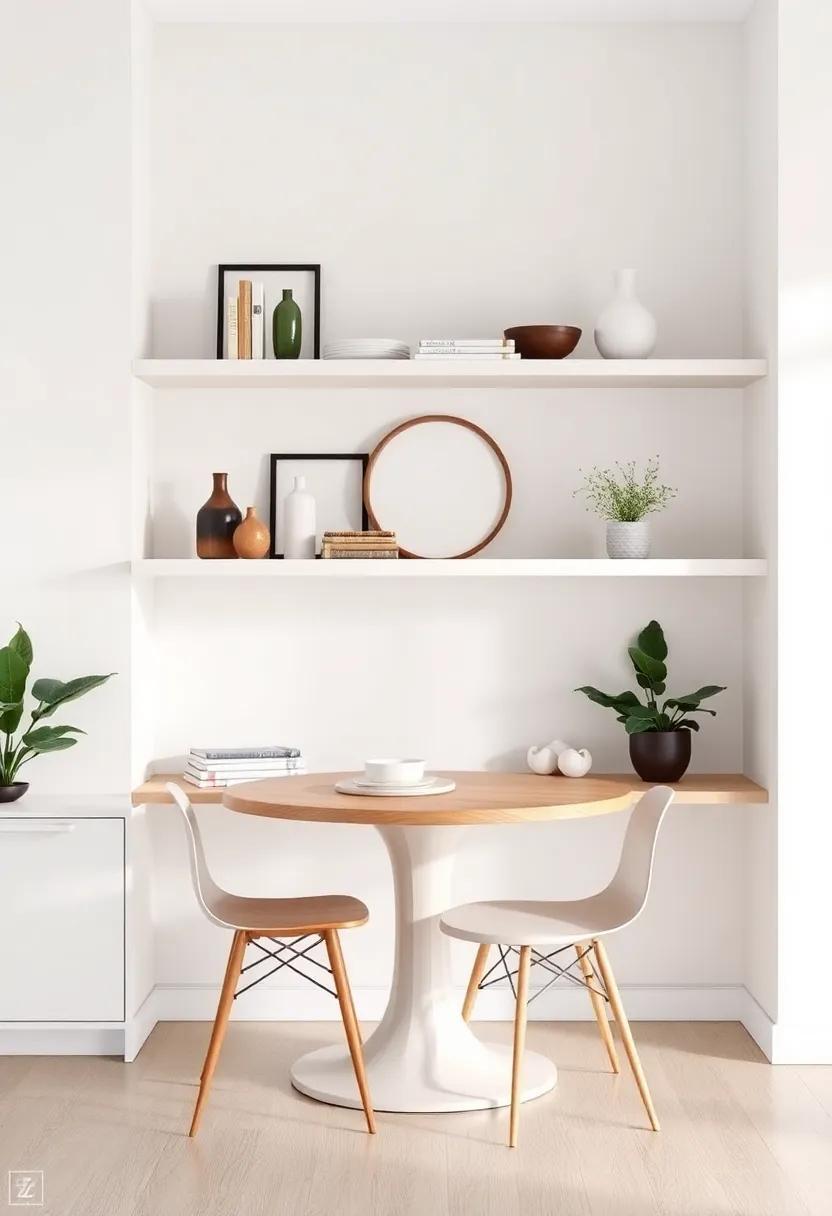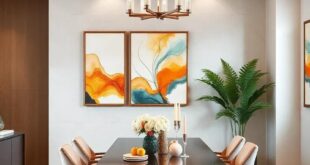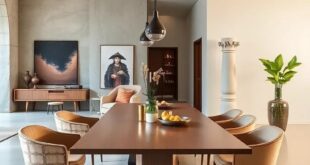When it comes to home decor, the dining room is often the heart of the home—a place where families gather, friends share laughter, and special memories are created around the table. Yet,while the eyes are usually drawn to the elegant dining set or the warm glow of ambient lighting,there’s another canvas waiting to be styled: your dining room shelves. These often-overlooked elements can serve as an opportunity to showcase personal flair,add visual interest,and enhance the overall atmosphere of the space. In this article, we’ll dive into a world of creative ideas to elevate your space, transforming standard shelving into stunning displays that reflect your unique taste and enhance the dining experience.From curated collections to striking color palettes, let’s explore how to infuse your personality into these functional aesthetics, turning every meal into an occasion to appreciate your beautifully styled surroundings.
Elevate Your Space with unique Decorative Objects for Dining Room Shelves
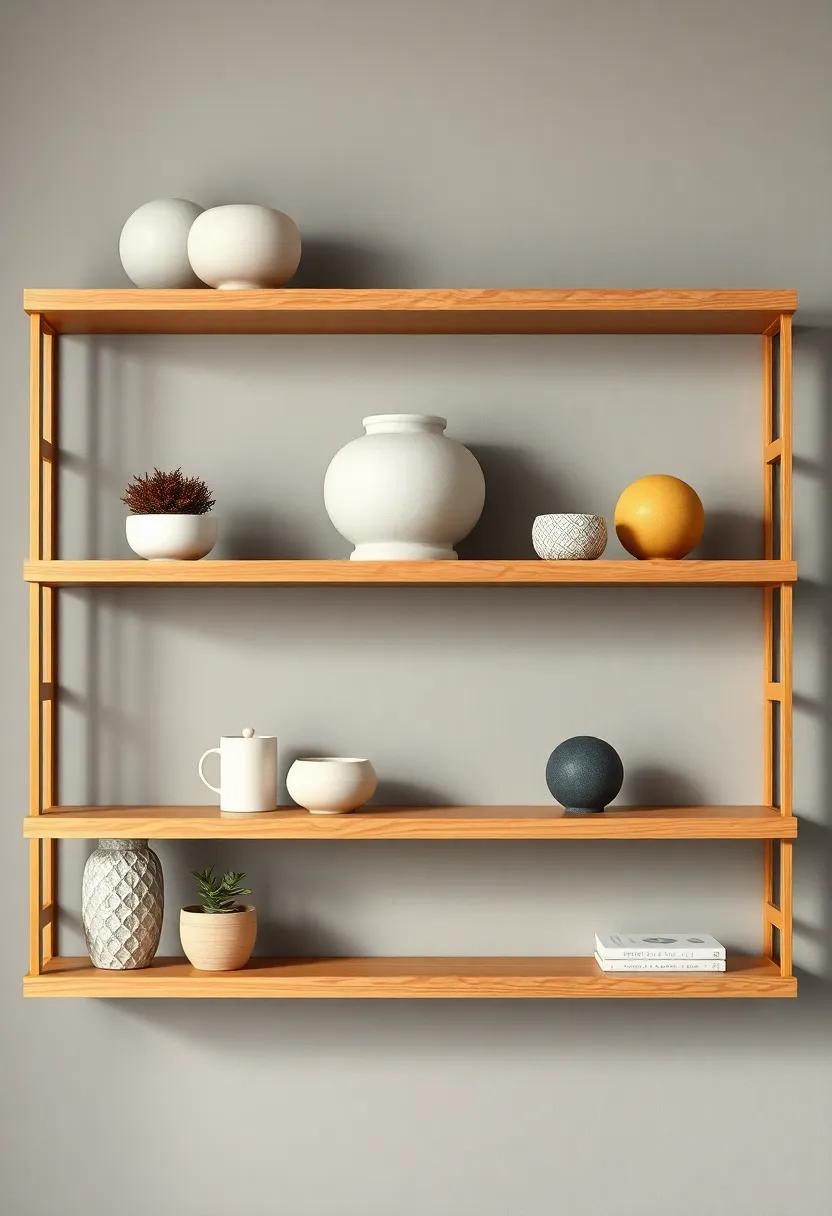
Transform your dining room shelves into a captivating display by incorporating decorative objects that reflect your personality and style. consider mixing textures, colors, and shapes to create visual interest. Choose from an array of unique items such as:
- Artistic vases: Opt for oversized or intricately designed vases that can serve as statement pieces.
- Stylish bowls: Select ceramic or wooden bowls filled with decorative stones or fruits to add a natural touch.
- Books: Incorporate a few carefully curated books that resonate with your taste, stacked or standing for variety.
- Framed art: display small artwork or photographs in unique frames to personalize your space.
- Sculptures: Use abstract or nature-inspired sculptures to add dimension and charm.
To ensure your decorative objects harmonize, consider creating a theme or color palette that ties everything together. You can utilize different heights and arrangements to maintain balance—think of clustering smaller items together while placing larger objects at the back. A speedy tip is to use the rule of three, as odd numbers often create a more inviting look. Below is a simple guideline for arranging your decor:
| Item Type | Suggestion |
|---|---|
| Vase | Place in the center for a focal point. |
| Books | stack them diagonally for a dynamic look. |
| Sculpture | Position on a lower shelf to draw the eye downward. |
| Art | Lean against the wall for a casual display. |
The Art of Layering: Create Depth and Interest in Your Dining Room Display

To bring your dining room display to life, embracing the art of layering is essential. Start by considering the varying heights and dimensions of your decorative items. As an example, you can use tall vases or candlesticks as focal points, placing them at the back of the shelf. Next, add medium-sized items, such as decorative bowls or books, aligned in the middle. incorporate smaller elements like framed photos or whimsical ornaments at the front. This technique not onyl creates a visually appealing hierarchy, but also draws the eye across the entire display, encouraging exploration of each layer.
Another effective strategy is to mix materials and textures to create visual interest. Combine elements such as wood, glass, and metal for a dynamic look. Pair rustic wooden trays with sleek glass vases or bold ceramic dishes. Additionally, consider using a variety of colors that harmonize while providing contrast. A simple way to achieve this is by selecting a cohesive palette and ensuring it flows throughout the items on display. To give a more curated feeling, you can group items in sets of three or five—this arrangement tends to be more aesthetically pleasing. Keeping these principles in mind will ensure your dining room shelves exude charm and creativity.
Mixing Textures: Incorporating Natural Materials for a Cozy Feel
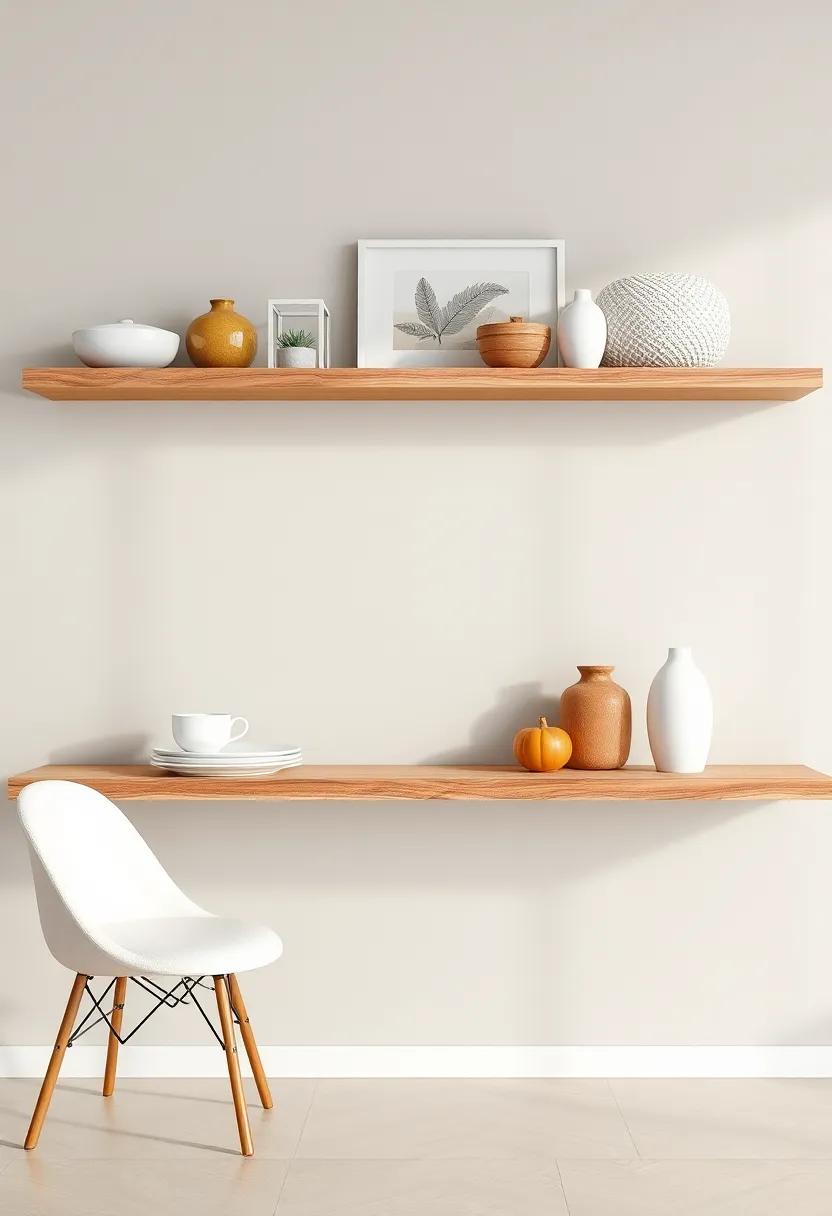
To create a warm and inviting atmosphere in your dining room, consider mixing various textures with the inclusion of natural materials. Wood,for example,can add a rustic charm,whether it’s through beautifully crafted shelves or decorative accents like wooden bowls and trays. Pairing these elements with softer textures, such as a knit throw or linen table runner, can enhance the tactile experience. Additionally, incorporating stone or ceramic pieces brings an earthy quality that complements the warmth of wood, helping to ground your design and create a harmonious balance.
Don’t shy away from integrating natural fibers such as rattan or jute into your shelving design. These materials not only add depth but also introduce a sense of organic simplicity. You might consider using rattan baskets to house smaller items or faux greenery, providing both functionality and style. When displaying your curated decor, create visual interest by layering textures. For instance, position a raw wood board beneath a polished ceramic vase, or arrange a collection of books alongside a woven sculpture. These thoughtful combinations will transform your shelves into a cozy yet refined focal point in your dining room.
Statement Pieces: Bold Centerpieces That Capture Attention
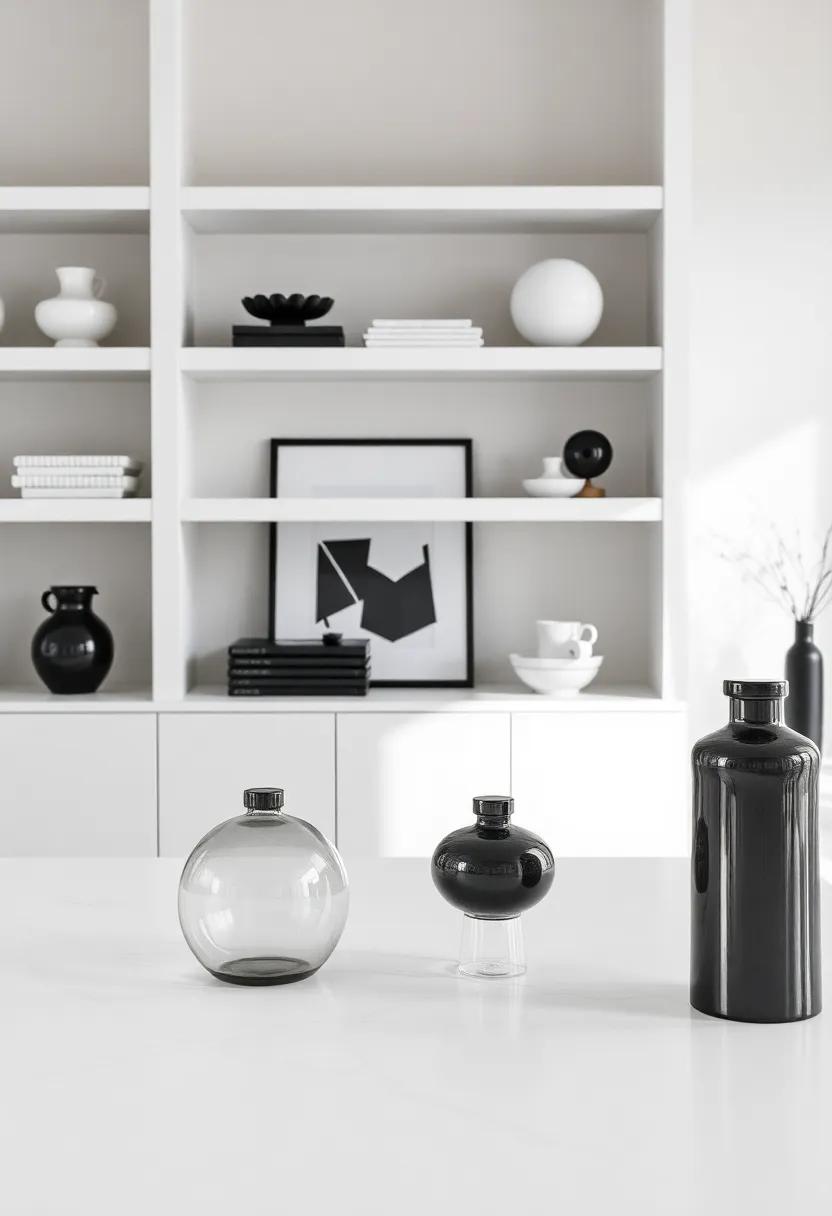
incorporating striking centerpieces transforms a mundane dining room into a captivating visual experience. Consider using a mix of sculptural vases and artistic bowls filled with seasonal elements such as dried flowers, fruits, or decorative stones.These pieces not only serve as focal points but also invite conversation, drawing guests’ eyes and sparking their interest.Candles in varying heights can add warmth and intimacy, while unique materials like brass, glass, or ceramic can enhance texture and depth on your shelves. Aim for a balance of shapes and sizes to create an engaging display that exudes personality.
For those who lean towards a more eclectic aesthetic, think about curating a collection of vintage finds or handcrafted items that tell a story. Layering objects with different heights and materials can create a dynamic effect. Whether it’s a bold statement sculpture,a colorful art piece,or an interesting coffee table book,these items should resonate with your style. Remember to leave some open space on the shelves to avoid overcrowding—this negative space allows each piece to stand out and breathe, making your dining room not just a place to eat, but also to appreciate artful decor.
Color Harmony: Choosing a Palette That Reflects Your Style

When curating your dining room shelves, selecting a color palette that resonates with your aesthetic can transform your space into a cohesive sanctuary. Think about the mood you want to evoke; whether it’s serene and minimalist or vibrant and eclectic, your choice of colors plays a pivotal role. Delve into a palette that speaks to your personal style by exploring these options:
- Monochromatic: Stick with varying shades of a single color for a sophisticated look.
- Complementary: Pair colors from opposite sides of the color wheel for a dynamic contrast.
- Analogous: Choose colors that sit next to each other on the wheel for a harmonious blend.
- Neutral with Pops of Color: Utilize a palette of soft neutrals adorned with bright accent pieces to create excitement.
Once you’ve settled on a color scheme, it’s time to think about application. Incorporate your chosen hues through decorative items, books, and even the shelving itself. For enhanced aesthetic appeal, consider the following elements:
| Element | Color Application |
|---|---|
| Books | Stack or group by color |
| Decorative Objects | Choose pieces in your palette |
| Vases or Planters | Opt for contrasting textures |
| artwork | Integrate larger pieces to anchor the palette |
By strategically applying your selected palette, you create a visually satisfying experience that not only emphasizes your personal style but also elevates the overall ambiance of your dining room. Consider how each color interacts and enhances the other, ensuring your shelves tell a story that is uniquely yours.
Creating Balance Through Symmetry and Asymmetry in Shelf Arrangements
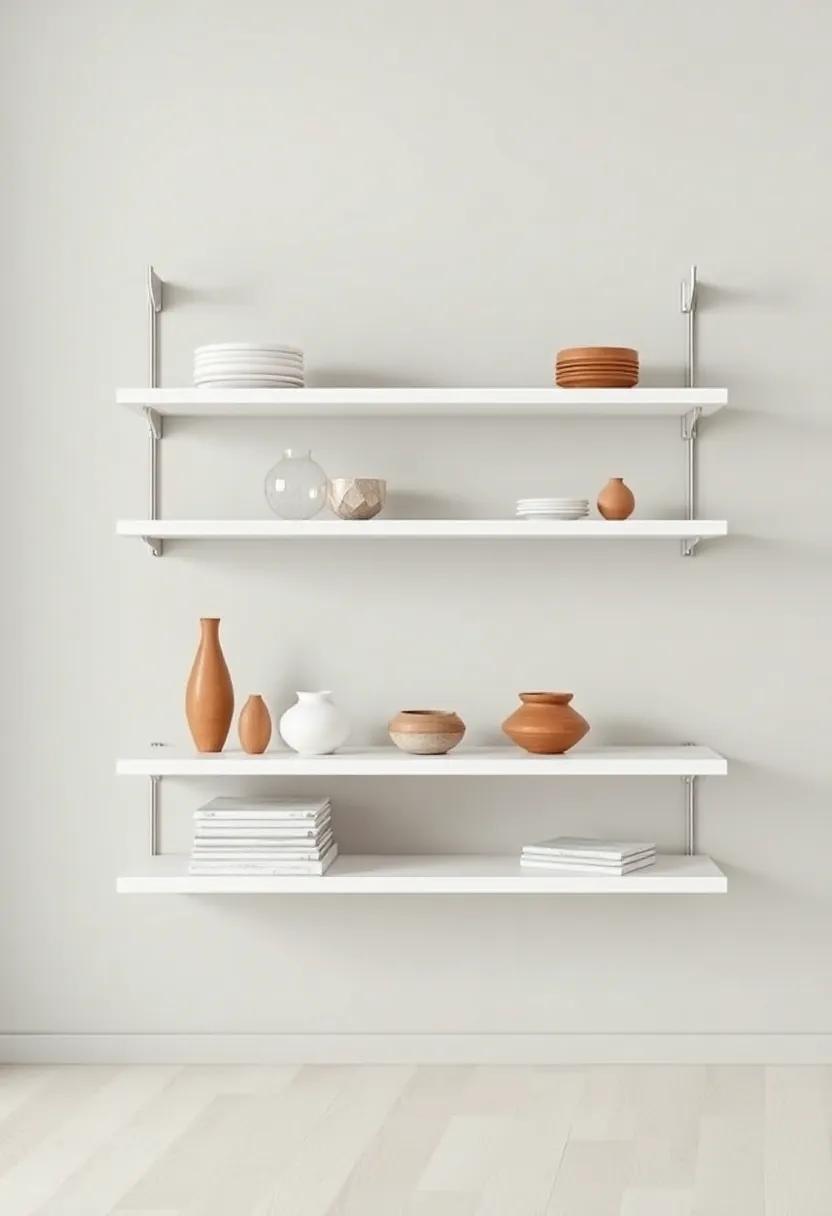
When curating your dining room shelves,the interplay between symmetry and asymmetry can create a dynamic atmosphere that draws the eye and captivates the mind. Symmetrical arrangements are excellent for instilling a sense of order and calmness, often employing matching objects to create visual harmony. Conversely, asymmetrical designs can inject energy into your space, allowing for creativity and spontaneity. to achieve balance,consider pairing elements with contrasting heights and textures,such as:
- tall vases juxtaposed with small books
- framed art on one side balanced by decorative trays on the other
- Clustered candles paired with singular artistic sculptures
To enhance the visual appeal,introduce layering techniques. Start with larger pieces as a base,followed by medium-sized items,and finish with smaller accents that bring depth to the arrangement. For instance, organizing your shelves in sections can facilitate both themes; the left could showcase a symmetrical approach, while the right embraces an asymmetrical layout. A simple table can illustrate this concept:
| Arrangement Type | Characteristics |
|---|---|
| Symmetrical | Orderly, mirrored, balanced forms |
| Asymmetrical | Dynamic, varied shapes, unexpected pairings |
Seasonal Display Ideas: Refreshing Your Dining Room shelves Year-Round
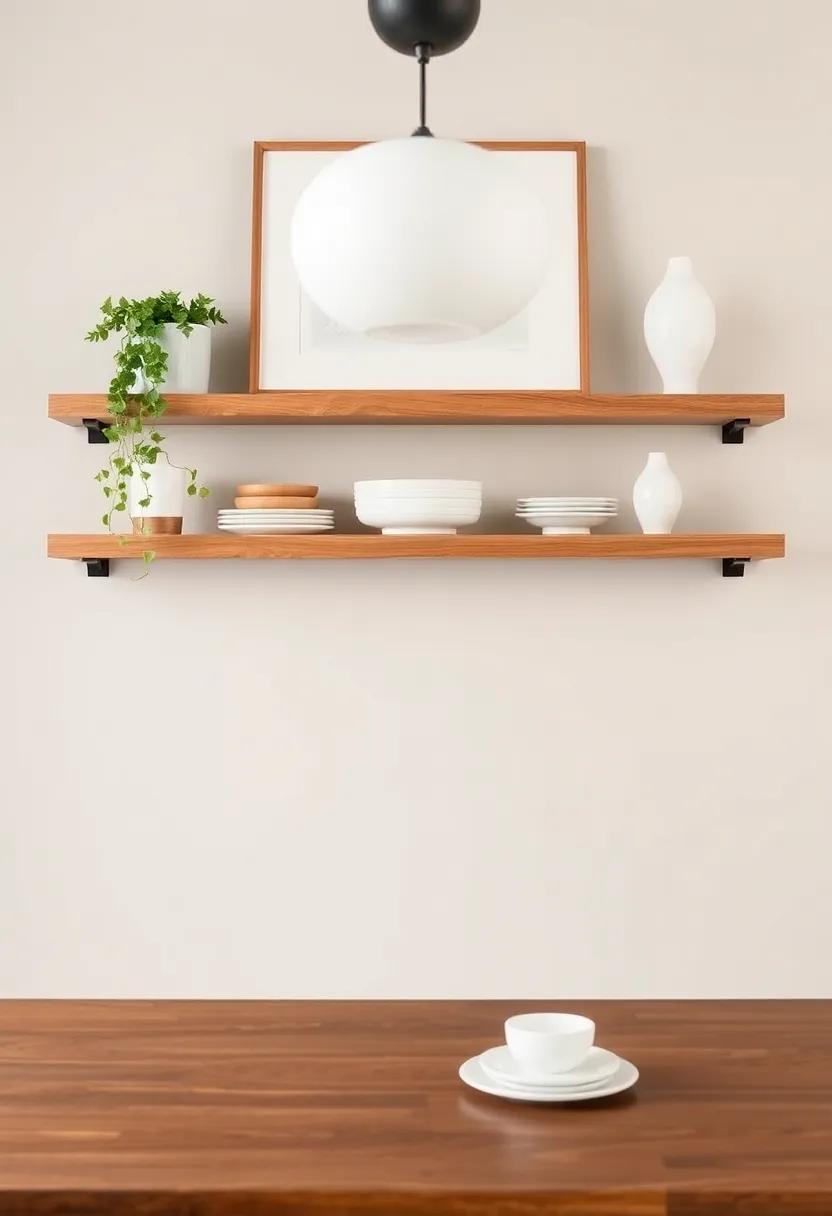
Transforming your dining room shelves to reflect the changing seasons can add a delightful freshness to your space. Consider using a mix of textures and colors that resonate with the current season. For spring, incorporate pastel-colored ceramics, fresh flowers in mason jars, and lightweight fabrics like linen or cotton.In summer, opt for vibrant hues with items like tropical fruit displays or woven baskets. Moving into fall, think about layering with rustic wooden accents, pumpkins, and earthy tones.winter can be graced with sparkling decorations, candles, and cozy items like knitted throws to create a warm, inviting atmosphere.
To ensure your shelves remain visually appealing throughout the year, consider utilizing a simple rotation system. This involves three main elements: functional pieces, decorative accents, and season-specific items. Create a table to plan your displays, specifying what to showcase each month. By keeping a balance between practicality and aesthetics, you can ensure your dining room shelves are not only beautiful but also serve a purpose.
| Month | Functional Pieces | Decorative Accents | Season-Specific Items |
|---|---|---|---|
| January | Cookbooks | Winter-themed Art | Cozy blankets |
| April | Serving Dishes | Floral Arrangements | Spring Blooms |
| July | Glassware | Colorful Vases | tropical Decor |
| October | Harvest Basket | Autumn Leaves | Mini Pumpkins |
Incorporating Personal Touches With Family Heirlooms and Artwork
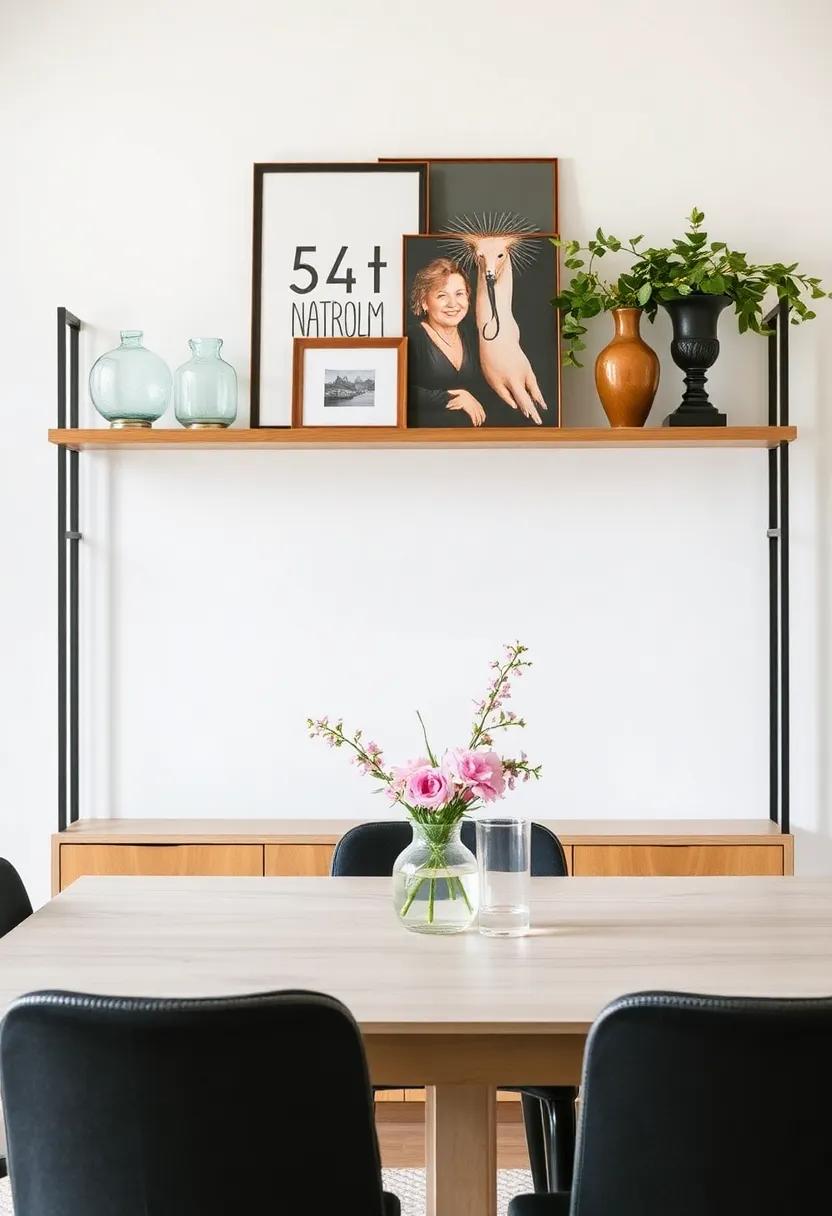
Integrating family heirlooms and original artwork into your dining room shelves not only personalizes your space but also sparks conversations and cherished memories. Consider showcasing handcrafted pottery that has been passed down through generations,or a vintage cutlery set that holds stories of past gatherings. By mixing these sentimental pieces with modern decor, you can create a visually captivating contrast that highlights the stories each item carries. Incorporate framed family photos,as these evoke nostalgia and warmth,making the dining experience more intimate.
To further enhance the visual appeal, arrange your heirlooms alongside carefully chosen artwork that reflects both your personality and the heritage of your family.This could include watercolor paintings of places meaningful to your family or vibrant abstract pieces that uplift the room. By alternating the heights and styles of these elements, you can create a dynamic display. Here’s a simple way to plan your arrangement:
| Item Type | Placement Suggestion | Visual Impact |
|---|---|---|
| Heirloom Pottery | Center stage or on a corner shelf | Bold focal point |
| Framed Photos | Layered behind other items or on the top ledge | nostalgic warmth |
| Original Artwork | Grouped or offset for asymmetry | Creative dynamism |
The Power of Plants: Bringing Life to Your Dining room Shelves

Incorporating greenery into your dining room shelves not only enhances the aesthetic appeal but also brings a sense of tranquility and life to the space. Plants can serve as vibrant focal points while complementing your existing decor. Choose between different types of foliage to create an engaging mix that captures attention:
- Trailing plants like pothos or philodendrons can add a cascading effect, softening sharp lines.
- Tall plants such as snake plants or fiddle leaf figs can create height variation, drawing the eye upwards.
- Air plants integrated into decorative containers or books can introduce a modern twist.
To achieve a harmonious look, it’s essential to consider the plant sizes and textures relative to your belongings. Use decorative pots that echo your dining room’s color palette while varying the heights for depth. You can also mix organic elements with stylish accessories in a curated display, such as:
| Element | Purpose |
|---|---|
| Books | Add character and a personal touch. |
| Vases | Provide a structured design element. |
| Candles | Introduce warmth and ambiance. |
Functional and Beautiful: Stylish Storage Solutions for Dining Essentials
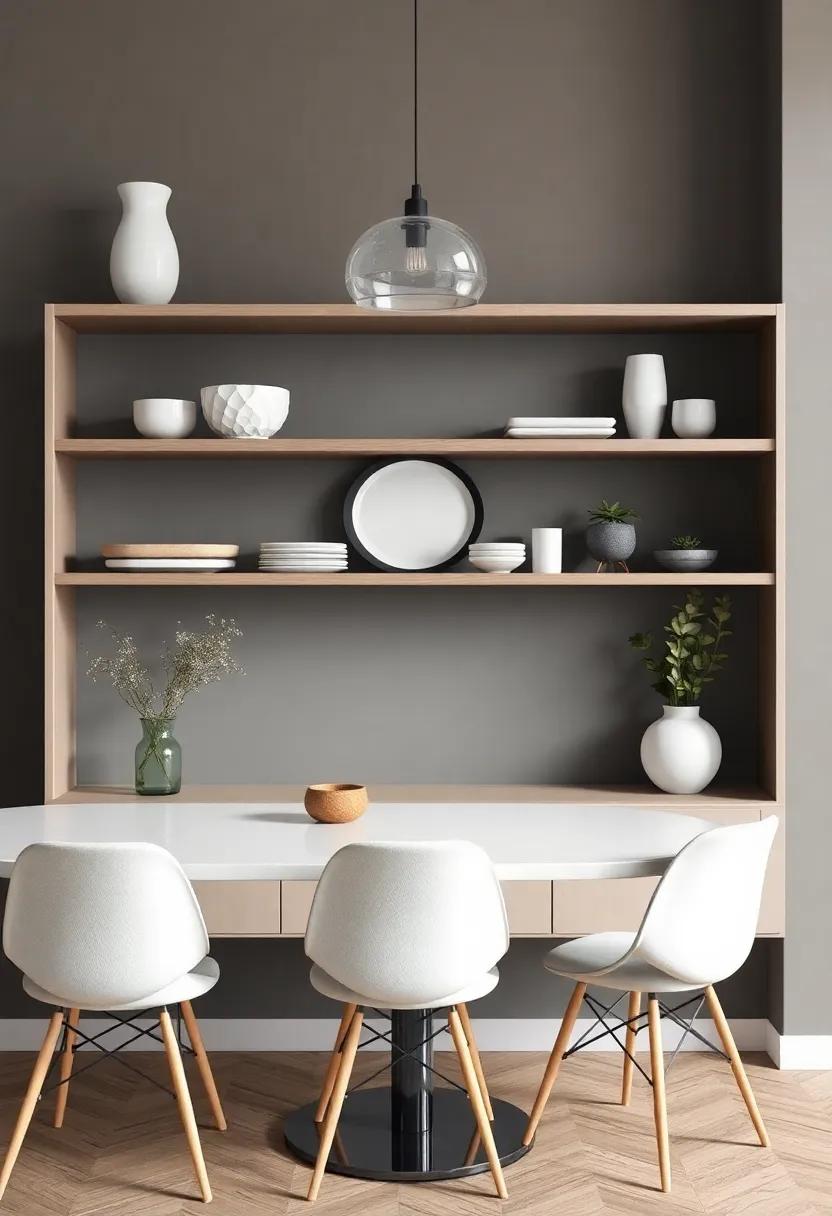
Transforming your dining area into a haven of style and functionality begins with thoughtful storage solutions that marry aesthetics with practicality. Consider incorporating a mix of open shelving and decorative cabinets to exhibit your finest dining essentials. Use unique items such as vintage tableware, handcrafted pottery, or vibrant glassware to bring character to your space. This not only enhances visual appeal but also makes your favorite pieces easily accessible. Here are some key items to showcase:
- Colorful dinnerware: Select plates and bowls that enhance your color scheme.
- Elegant glassware: Display an assortment of glasses to add sophistication.
- Serving trays: Use decorative trays to organize and present essential items.
By choosing pieces that contribute to a cohesive design, you can strike the perfect balance between beauty and function. To maintain a curated look, consider a neutral backdrop with pops of color from the items you choose. You might also utilize decorative baskets or boxes to store miscellaneous items, keeping your shelves tidy while adding to the visual interest. For easy reference, here’s a quick comparison of storage solutions based on their features:
| Storage Solution | Features | Style |
|---|---|---|
| Open Shelving | Accessible and display-pleasant | modern and airy |
| Glass Cabinets | Protects items, showcases elegance | Chic and refined |
| Decorative Baskets | Organizes and adds texture | Casual and rustic |
Playful Patterns: Using Fabrics and Tableware to Enhance Your Space
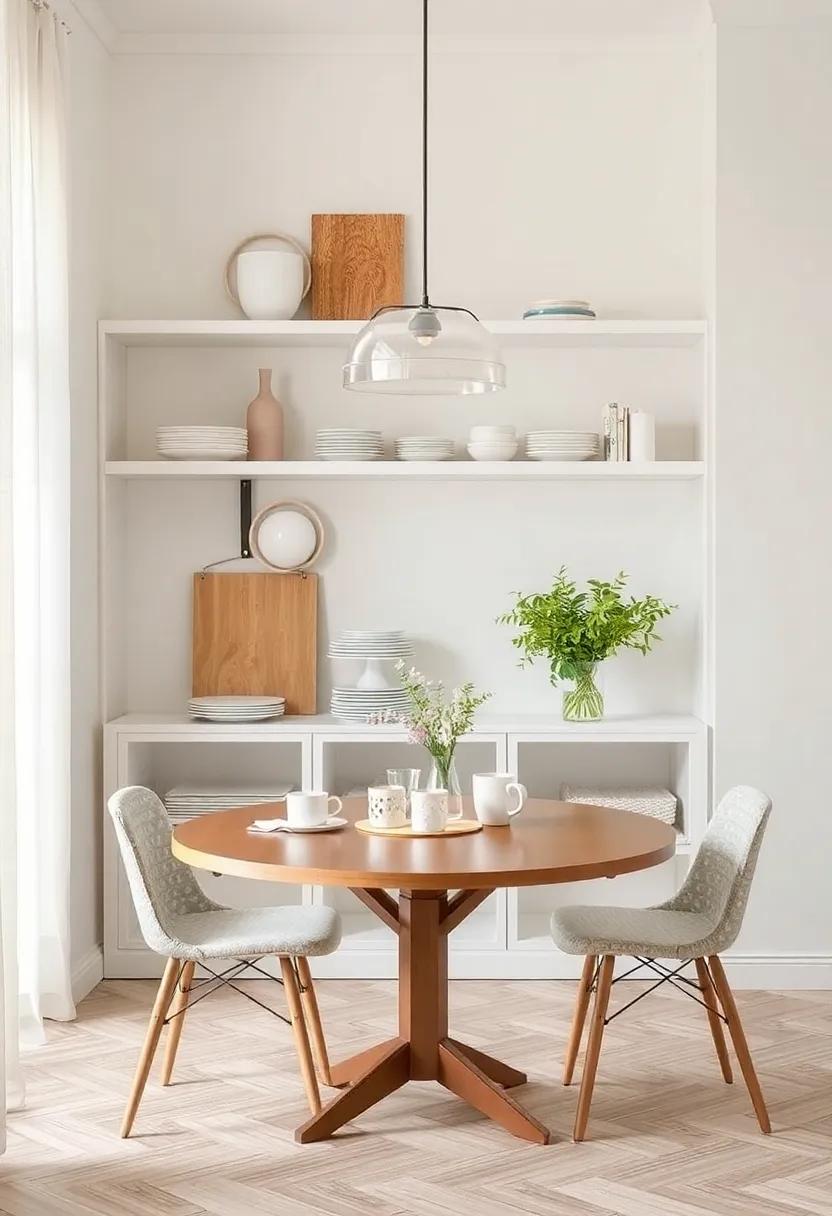
To create a vibrant and inviting atmosphere in your dining room, embrace the charm of textured fabrics and whimsical tableware.Select table linens adorned with bold prints or playful patterns to bring a sense of delight to your shelves. Explore options like florals, stripes, or geometric shapes to create contrast and visual interest. Layer these textiles with wooden or ceramic serving pieces that echo the colors of your fabrics, thus weaving a cohesive design story throughout the space.
Pairing your fabric selections with distinct tableware can elevate the overall aesthetic. Consider using an array of interesting plates or unique glassware that complement the themes of your linens. Create a captivating display by incorporating various heights—stack plates or place small bowls atop larger ones. Incorporate items like patterned napkins and decorative chargers to further enhance the layering effect. For a chic touch, opt for a complementary color palette that unites your fabrics and tableware, making each element stand out while harmonizing beautifully.
Layering Lighting: The Impact of Ambient and Accent Lighting on Shelves
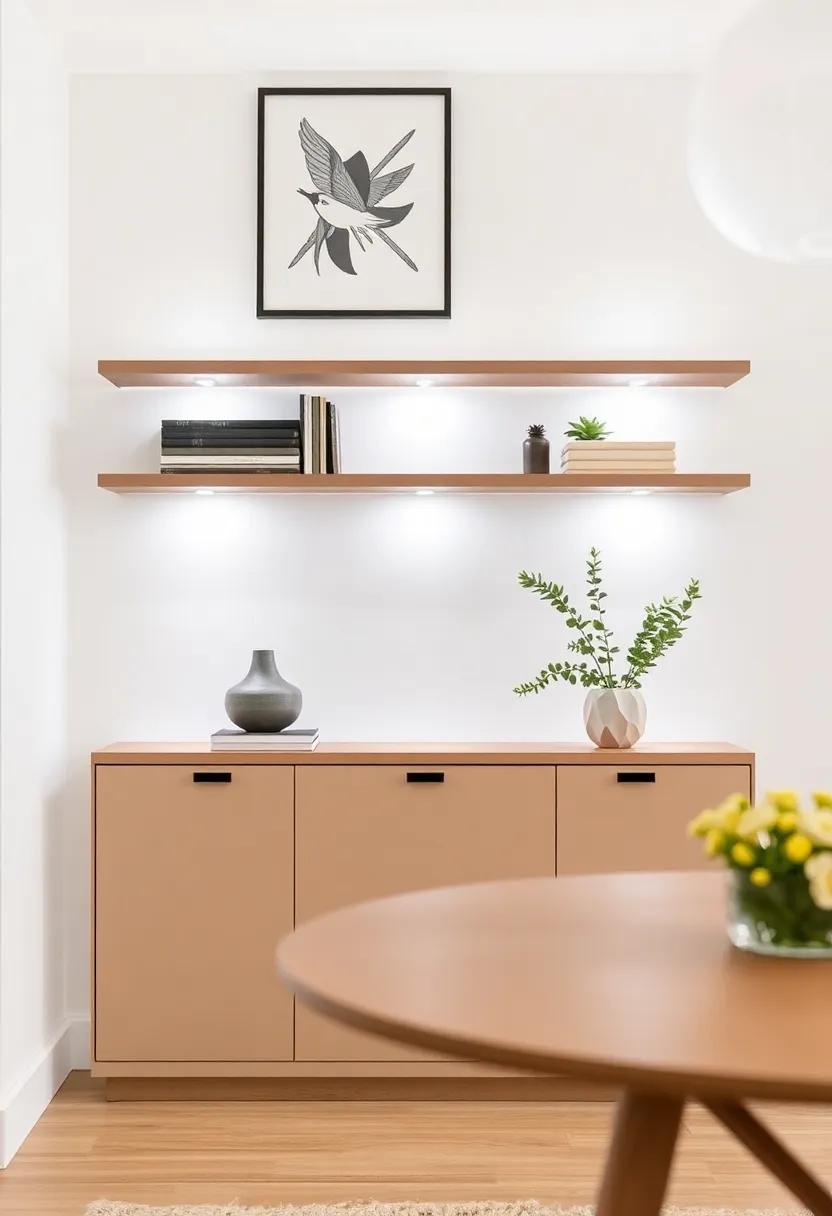
Achieving the perfect balance between functionality and aesthetics on your dining room shelves can be greatly enhanced through prudent use of lighting. Ambient lighting, which provides overall illumination, can set the tone for the space, allowing your shelves to glow softly without overwhelming the eyes.Incorporating recessed lighting or chic pendant lamps above the shelves not only brightens the area but also highlights the beauty of your curated pieces. Conversely, accent lighting serves to draw attention to specific items such as artful ceramics, cherished photographs, or unique collectibles. wall-mounted spotlights or small track lights can illuminate these focal points, creating visual interest and depth that can transform a simple shelf into a captivating feature of your dining room.
When considering the placement of your lighting, think about layering these elements to achieve a cohesive look.A strategic combination of ambient and accent lighting allows for versatility in both appearance and mood. Here are a few tips to blend these two types of lighting effectively:
- Use dimmers: This allows you to adjust the brightness depending on the occasion.
- Experiment with angles: Direct light at an angle for softer shadows and richer textures.
- Mix light temperatures: Combine warm and cool white lights to create dynamic contrasts.
To visualize how these layers interact,consider the following table which highlights different lighting styles and their impacts:
| Lighting Style | Purpose | Best Used For |
|---|---|---|
| Ambient Lighting | Overall Illumination | Creating a warm atmosphere |
| Accent Lighting | Highlighting Specific items | Focusing on decor or art |
| Task lighting | Functional Lighting | Reading or detailed work |
Artful Stacking: The beauty of Arranging Books and Decorative Items
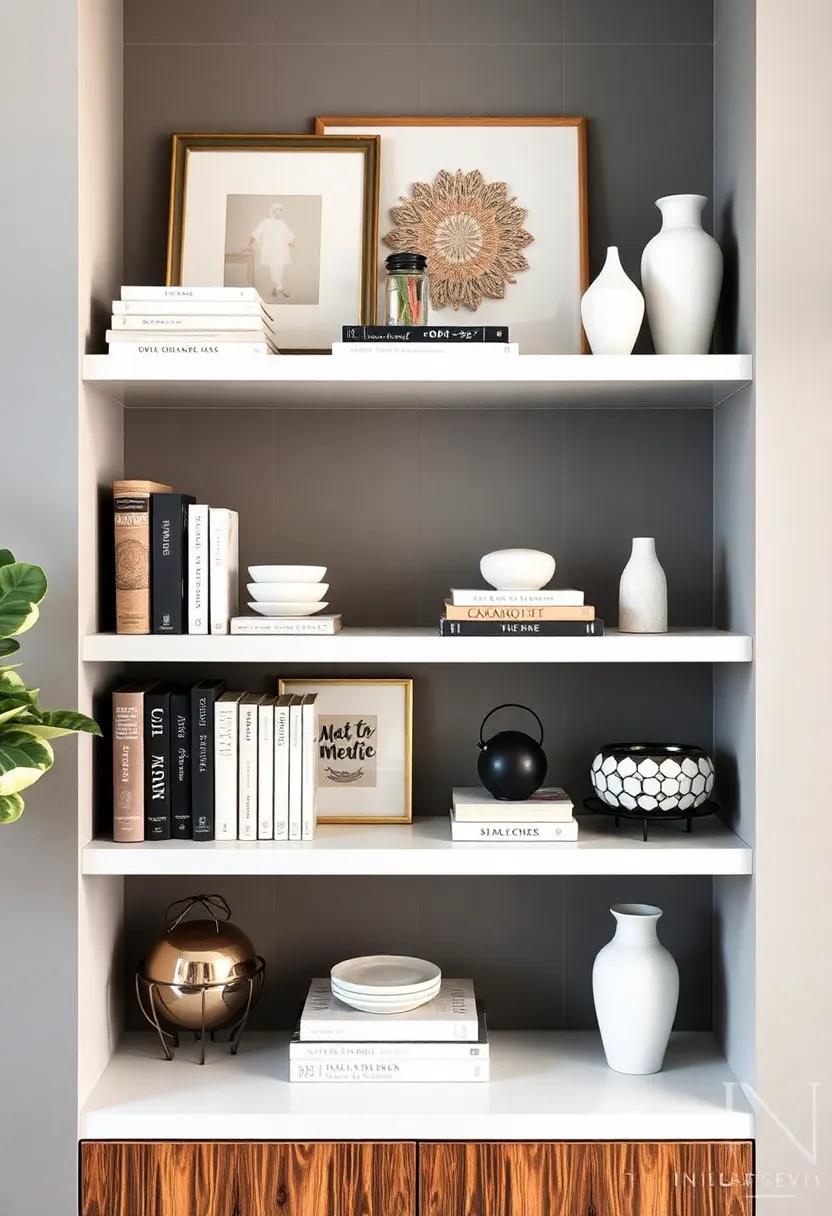
Imagine opening a dining room shelf to reveal a carefully curated collection that tells a story. To achieve an artful arrangement, start with balance: use books of varying sizes—stack some vertically and others horizontally. This not only adds depth but serves as a practical base to anchor decorative items. Complement your books with decorative objects that reflect your personal style.Think about layering textures through items like ceramic vases, natural elements such as driftwood, or metallic accents that catch the light.
Consider incorporating a color scheme that resonates with your dining area while allowing for contrast.For instance, a neutral palette can be livened with splashes of color from artwork or fruit bowls. When choosing decorative items, opt for pieces that vary in height and form. Use small trays or stands to elevate certain objects,drawing the eye around the shelf. Remember, it’s all about the visual flow: allow space for each piece to breathe, creating an inviting display that is as functional as it is aesthetically pleasing.
Contrasting Colors: Using Bold Hues for Eye-Catching shelving Designs
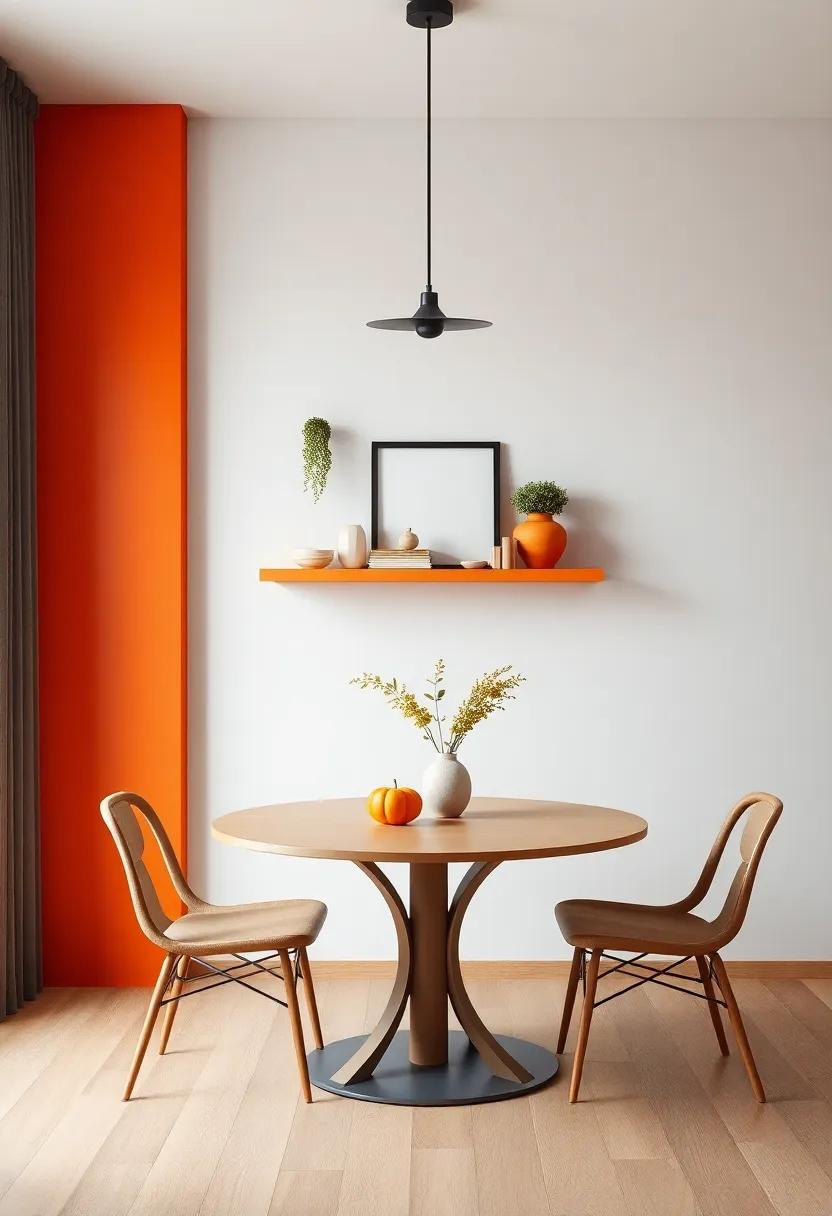
When it comes to designing your dining room shelves, leveraging bold hues can dramatically transform your space. Think beyond the conventional neutrals and embrace a palette that speaks to your personality and complements your decor. As a notable example, a vibrant turquoise can create a stunning contrast against warm wood tones, while a deep emerald green brings a touch of sophistication and depth. Pairing these bold colors with an assortment of decor items such as ceramics, glassware, or even art pieces can create a mesmerizing focal point. To make an even bolder statement, consider using a two-tone approach, where the shelves themselves are painted in contrasting colors for an eye-catching effect.
To successfully incorporate these striking colors, it is essential to maintain a balance throughout your shelves. Here are some tips to ensure that your design remains cohesive and inviting:
- Choose a Color Scheme: Limit your palette to 3-4 colors that harmonize well together.
- Use Accent Pieces: Incorporate small items in bold colors, such as books, vases, or framed art.
- Vary Textures: Mix materials like wood, metal, and glass to add visual interest.
- consider Lighting: Use warm lighting to enhance the vibrancy of your chosen hues.
| Color | Mood |
|---|---|
| Turquoise | Refreshing |
| Emerald Green | Calming |
| Coral | Energetic |
| Mustard Yellow | Warmth |
Incorporating Curiosities: Adding Unique Finds to Your Dining Room Shelves
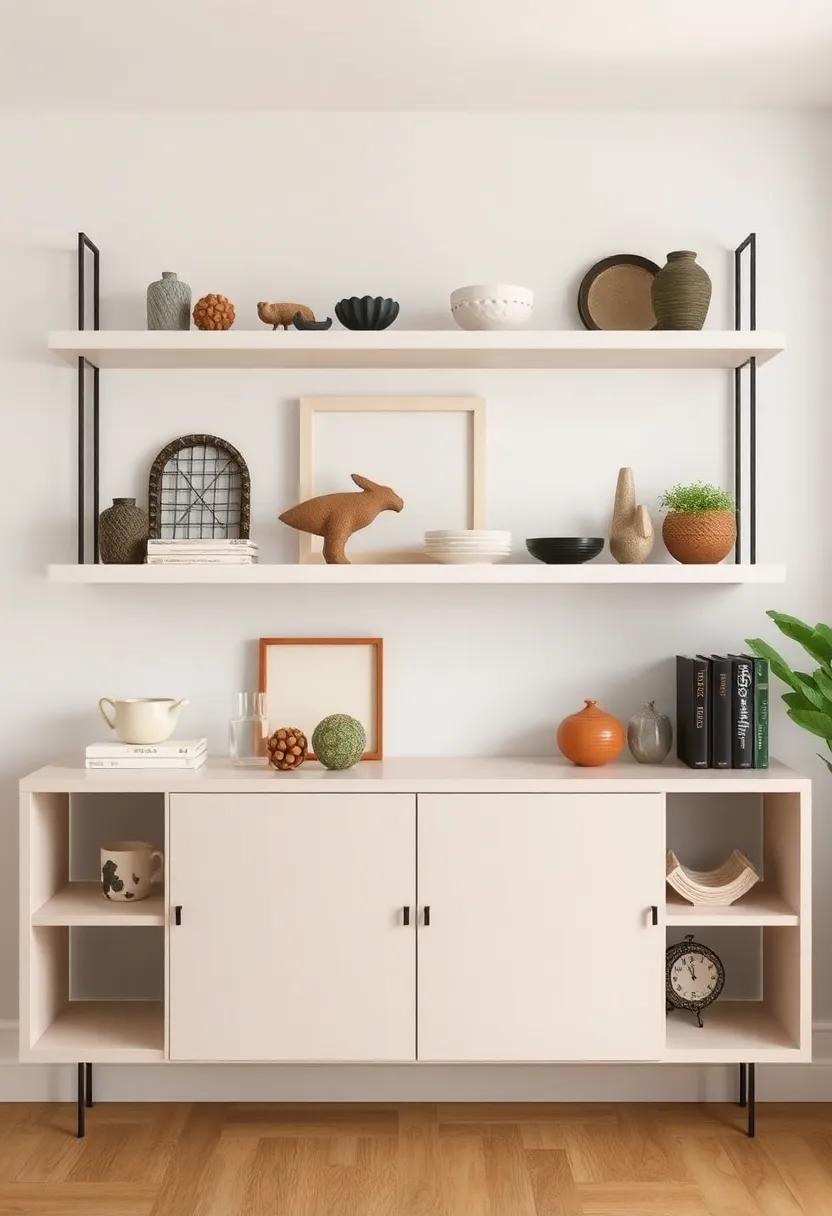
One of the most rewarding aspects of styling your dining room shelves is the opportunity to showcase unique finds that reflect your personality and spark conversation. Consider integrating a mix of eclectic items, such as vintage books, handcrafted pottery, or interesting sculptures. Each piece can tell a story, creating a narrative throughout your space that invites guests to explore your shelves. Try incorporating various styles and materials to enhance visual interest:
- Antique treasures: Items from flea markets or family heirlooms can add a sense of history.
- Artistic elements: Think abstract pieces or modern art that contrasts with more conventional dining settings.
- nature-inspired decor: Dried flowers, unique stones, or even small potted plants bring life to your arrangement.
To elevate your unique finds, consider organizing them on your shelves in a way that balances both height and depth. Utilize varying levels by playing with the placement of items; stack books horizontally and use them as platforms for smaller decor pieces. If you’re unsure how to arrange these items cohesively, refer to a simple layout like the one below:
| Item Type | Best Placement |
|---|---|
| Vases | Center stage on a middle shelf |
| Books | Stacked on lower shelves with decorative objects |
| Sculptures | Top shelf stands for height variation |
| Plants | Scattered across various levels |
Cohesive Themes: Curating a Specific Aesthetic for a Polished look

Creating a cohesive aesthetic for your dining room shelves involves a thoughtful selection of items that harmonize in style,color,and texture. Start by identifying a color palette that resonates with your overall decor. This could be muted pastels for a serene ambiance, or bold jewel tones for a lively atmosphere. Focus on incorporating a mix of elements such as:
- Textiles: Soft fabrics like table runners or napkins can introduce warmth.
- Artwork: Small framed prints or mini canvases add a personal touch.
- Natural elements: Consider plants or flowers to bring life and freshness.
To elevate your display further, embrace the concept of layers and heights. Varying the elevation of your decorative items adds depth and intrigue to your shelves. Use stylish risers or stack books to create different levels, enhancing visual interest. Incorporate a few standout pieces that can draw the eye, such as a sculptural vase or an antique find. here’s a simple table to summarize some key layering strategies:
| Layering Strategy | Effect |
|---|---|
| Utilize varying heights | Adds dimension |
| Mix textures | Creates contrast |
| Group items in odd numbers | Enhances visual appeal |
Gallery Style Shelving: Treating Your Dining Room Like an Art Showcase
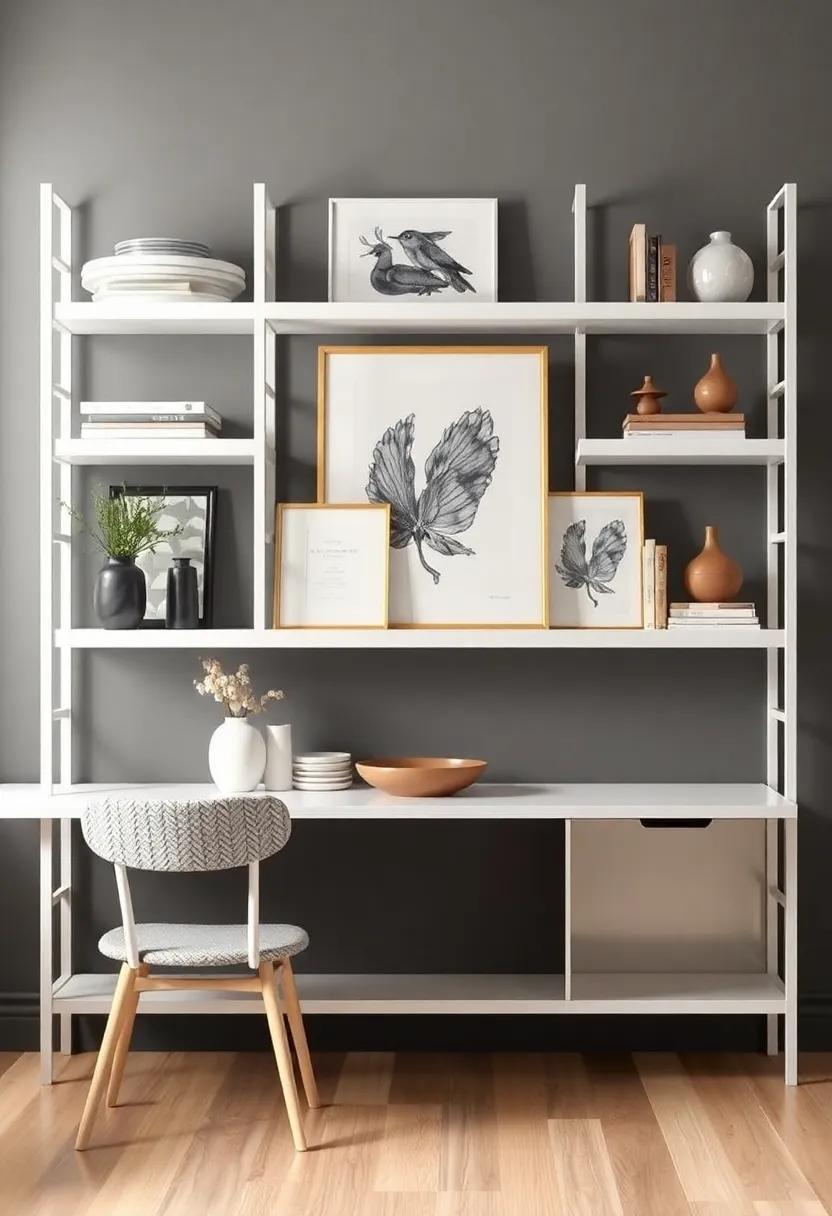
Turn your dining room shelves into an artistic display with gallery-style shelving that combines functionality and creativity. By thoughtfully arranging your dishes,glassware,and decorative pieces,these shelves can reflect your personality and taste. Consider incorporating a variety of elements such as:
- Artwork: Frame small prints or hang plates as original art pieces.
- Natural Elements: Integrate plants or floral arrangements to add life and color.
- Curated Collections: Showcase your favorite items, like vintage cookbooks or unique pottery, to tell a story.
- Complementary Textiles: use tablecloths or cloths in soft colors to give an added textural feel.
For a more structured look, create a visual balance by grouping items in odd numbers and varying the heights. This dynamic arrangement draws the eye and creates interest without feeling cluttered. Mixing materials, such as wood, metal, and ceramics, can also enhance the visual appeal of your shelves. Consider this simple table to help you visualize the arrangement:
| Element | Purpose |
|---|---|
| Books | Foundation for layers, adds height |
| Vases | Brings softness and organic form |
| Glassware | Shines with light, adds elegance |
| Personal Mementos | Showcases your character and history |
incorporating Vintage Elements: The Charm of Retro Finds in Modern Spaces
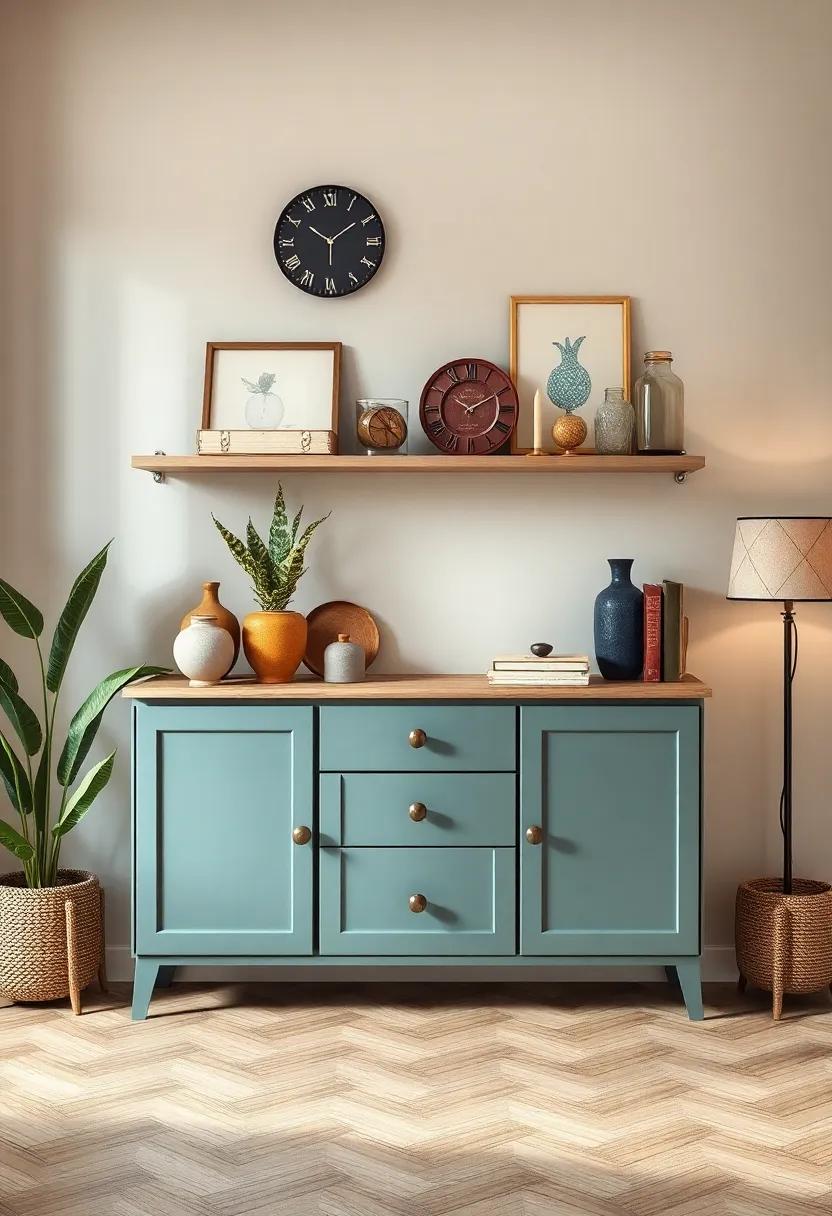
Incorporating vintage finds into your dining room shelves can create a distinctive look that reflects personality and adds depth to modern decor.Consider mixing antique dinnerware with contemporary pieces to establish a refreshing contrast. This variety can be achieved by displaying a set of ornate china next to minimalist ceramic bowls or alongside vibrant glassware. Incorporate weathered wooden crates or metal baskets to house items like napkins, tablecloths, or even cookbooks, introducing a rustic charm that softens sleek finishes.To draw attention to these vintage treasures, place them against neutral backgrounds, allowing their intricate details to shine.
Think about adding personal touches by showcasing heirloom items that tell a story. A vintage vase or a family recipe box can serve as a focal point, evoking nostalgia while still being functional. Layering textures is another effective strategy; combine soft fabrics with rougher elements like stone or metal to create visual interest. Consider a simple table featuring items arranged in a grid layout for structured appeal, or opt for an eclectic format that encourages exploration. You can enhance the display by using a mix of heights—varying the placement of books, framed photos, and memorabilia to keep the eye engaged.
Functional Decor: Items That Serve Both Purpose and Style
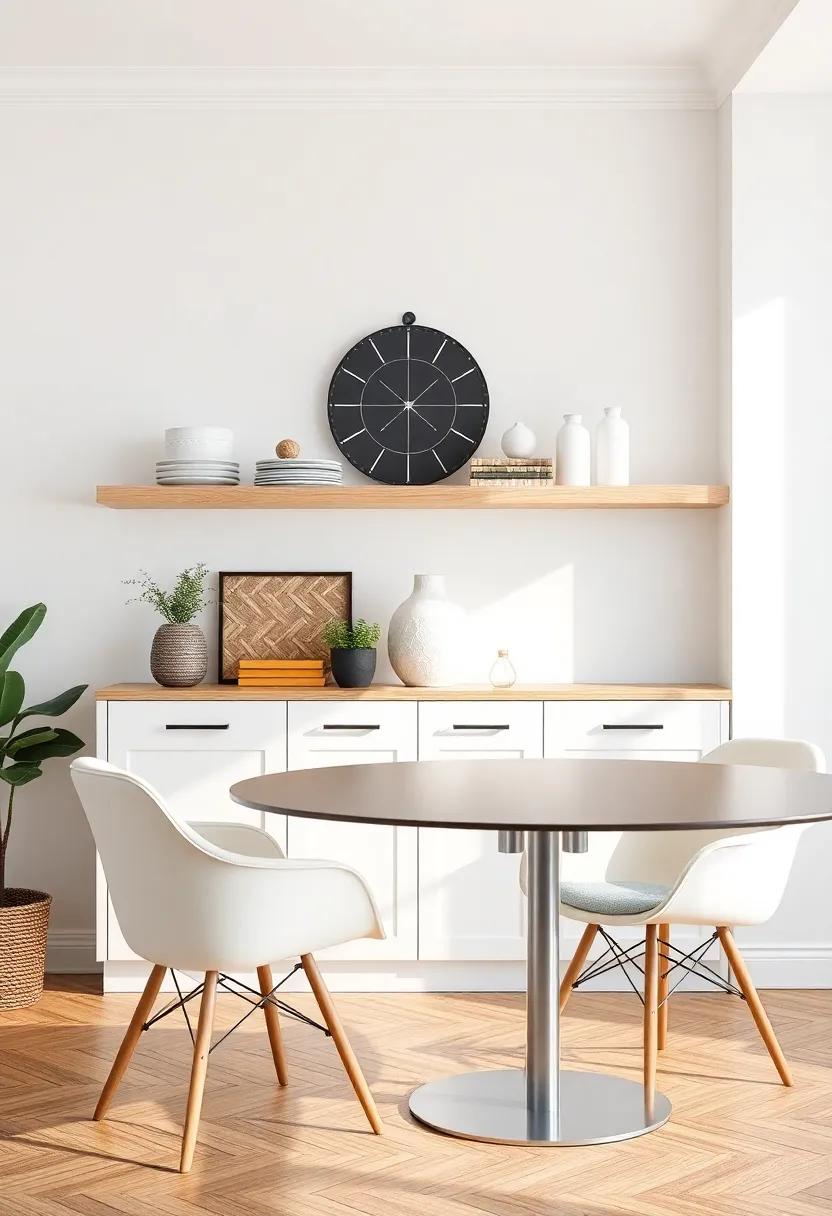
The dining room shelves offer an excellent opportunity to combine functionality and aesthetics.Look for items that not only look good but also serve a purpose. Consider beautiful baskets for storing napkins or table linens; these can be both decorative and practical. Another great option is stylish dinnerware that doubles as decor. Stack colorful plates, or use oversized bowls as focal points on your shelves. Glass jars filled with grains, pasta, or other ingredients can also add elegance and clarity while keeping your essentials close at hand.
Incorporating elements that tell a story can elevate your dining room even further. For example, mix in handcrafted items, such as pottery or locally sourced art pieces, that resonate with your personal style. This not only beautifies the space but also showcases your travel or collecting experiences. To keep things visually interesting, consider the Rule of Threes when arranging items on the shelves—grouping them in sets can create balance. Remember, the goal is to create harmony, so incorporate both simple and bold elements to have your dining room reflect your unique character.
Creating a Cozy Nook: Styling A Small Dining Space With Personality
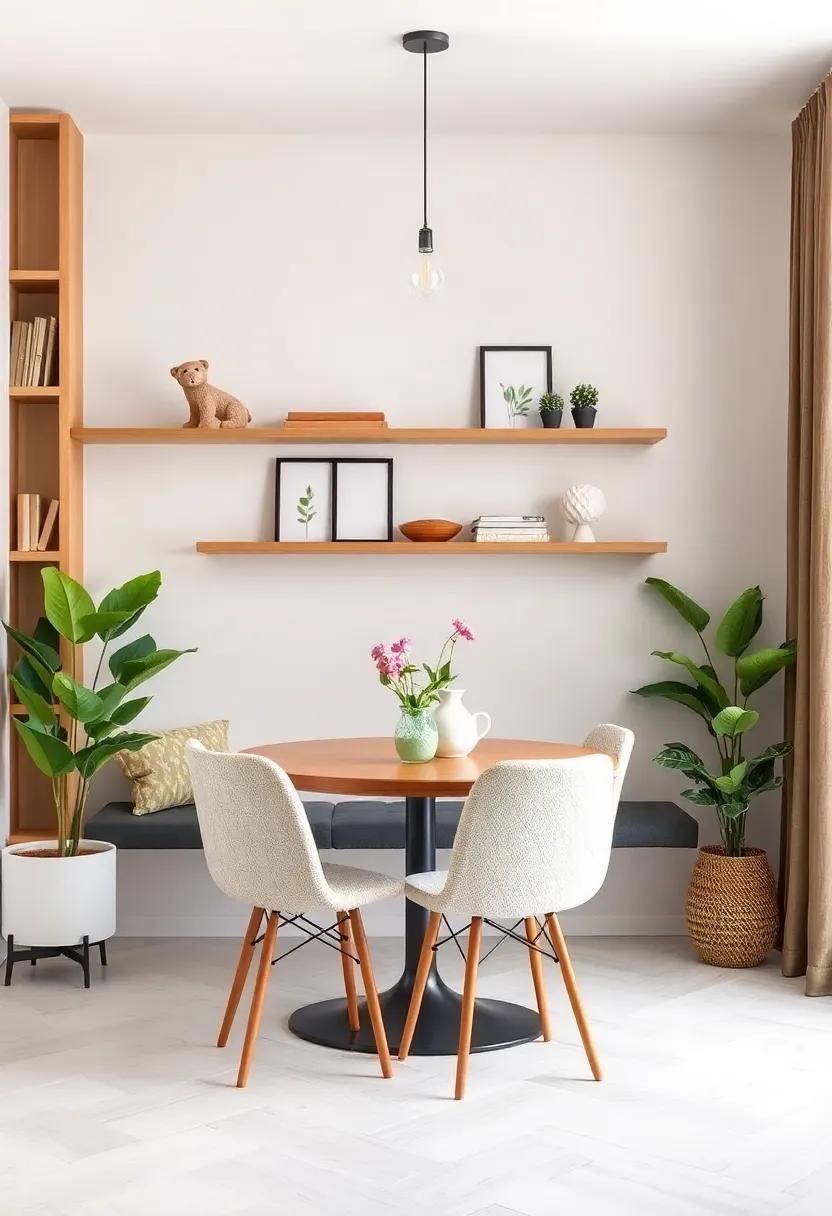
Transforming a small dining space into a cozy nook brimming with personality is all about thoughtful styling and strategic layering. Start by incorporating soft textiles like woven placemats, plush cushions, or a delicate throw to add warmth and texture. You can also enhance the ambiance with mood lighting using small pendant lamps or fairy lights that create an inviting glow. A well-chosen table centerpiece, such as a vibrant floral arrangement or a unique sculpture, can serve as a focal point, while a collection of eclectic dining ware can introduce an element of surprise, telling a story through your choices.
Don’t forget the walls—they offer a canvas for your creativity. Consider adding open shelving to display your favorite dishware, cookbooks, or travel souvenirs, allowing them to be both functional and decorative. A gallery wall featuring framed photos or artwork that resonates with your dining experiences can further enhance your cozy nook. To optimize the space visually, you might use a small dining table paired with mismatched chairs to foster a relaxed and personalized vibe. If you have enough room, a stylish sideboard or cart can provide additional storage while showcasing curated décor items.
Reflective Surfaces: Using Mirrors and Glass for Added dimension
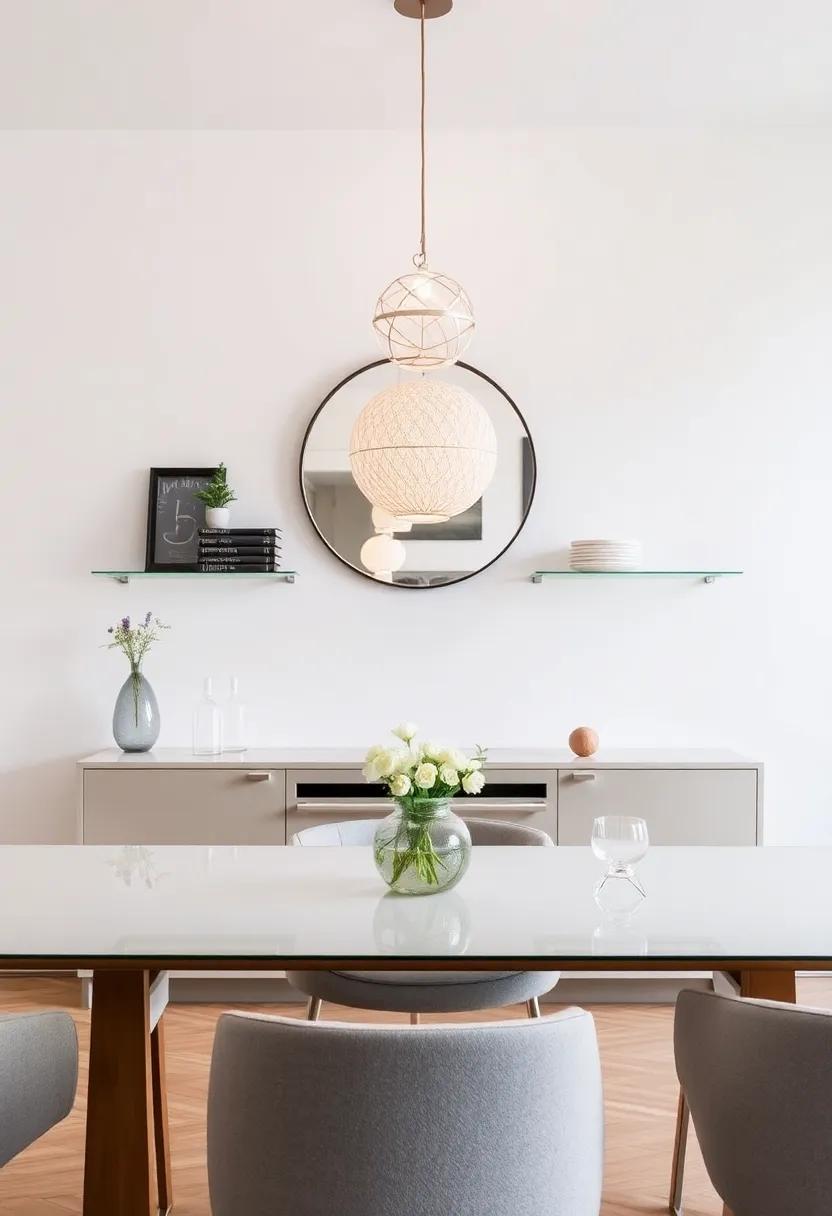
Integrating reflective surfaces such as mirrors and glass into your dining room decor can significantly enhance both style and functionality. Mirrors, strategically placed on shelves or walls, can create an illusion of wider space, amplify natural light, and draw attention to your curated decorations.Consider layering a sleek, framed mirror above your shelf to highlight a collection of plates or glassware, allowing the light to bounce off the reflective surface and create a dazzling focal point. The interplay of reflections can add depth to your space while inviting a sense of elegance that feels both modern and timeless.
Incorporating glass elements adds a touch of sophistication, transforming everyday items into eye-catching decor. Whether it’s through the use of glass vases, bowls, or even shelving itself, these transparent components can provide a clean aesthetic that enhances the overall flow of the room. Experiment with different heights and shapes in your glass selection to create visual interest and balance. Here are a few ideas to consider for your dining room shelves:
- Clustered Glass Vases: Use varying sizes for a dynamic look.
- Artful Glass bowls: Display fruits or decorative stones.
- mirrored Trays: Organize candles or other small items while adding reflection.
Creating Visual Interest With Different Shelf Heights and Arrangements
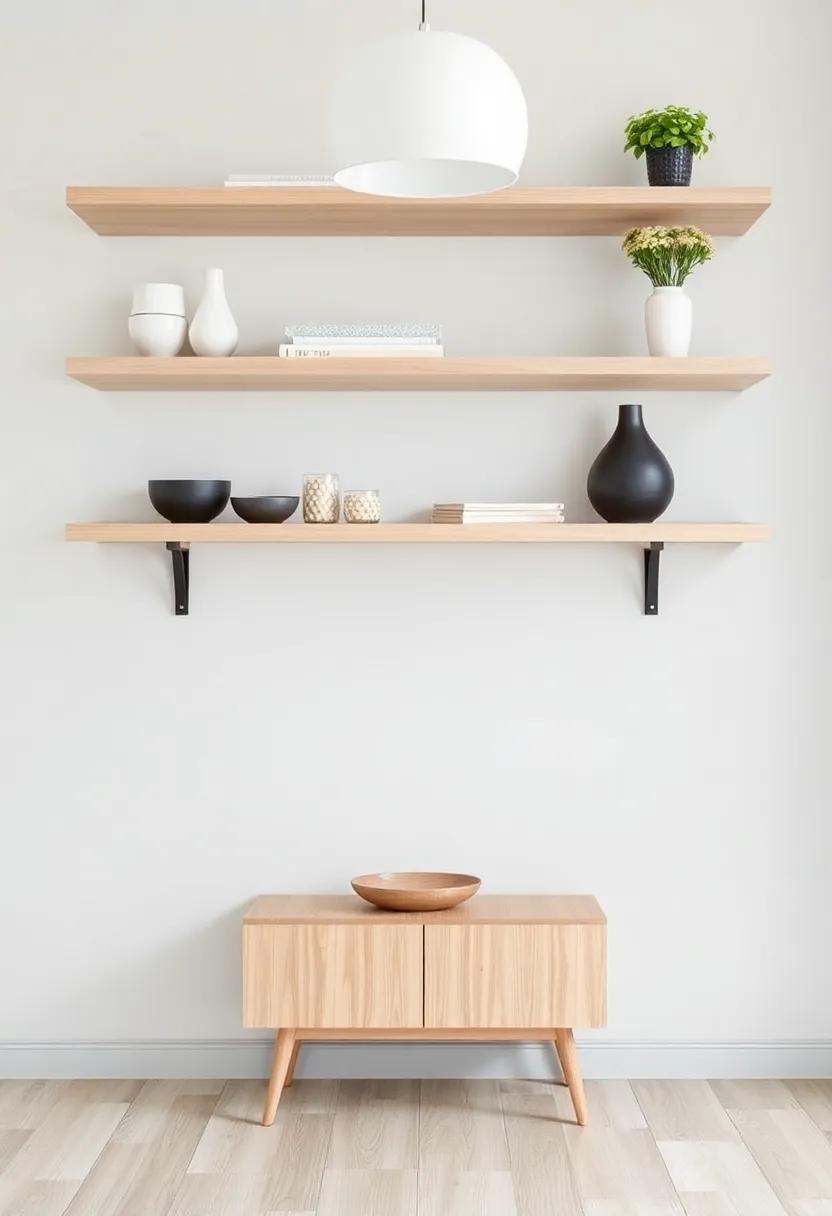
One of the most effective ways to enhance the aesthetic appeal of your dining room shelves is through varying the heights and arrangements of the items displayed. By utilizing an assortment of sizes and shapes, you can create a dynamic visual experience that draws the eye and invites exploration.Consider incorporating tall vases or statement pieces on the top shelves, while reserving lower shelves for smaller decorative objects or books. This approach not only adds depth, but it also encourages a more engaging narrative as guests examine the eclectic mix.
Another technique is to experiment with consolidated groupings versus scattered arrangements.Grouping similar colors or themes together can create a unified look,while interspersing items from different sets throughout the shelves can evoke a more casual vibe that feels inviting. Incorporate floating shelves for versatility; they can be positioned at different heights to enhance interest. Remember to balance heavier items with lighter ones, ensuring each shelf tells its own story while contributing to the overall design of your space. Below is a quick reference table to inspire your next shelving arrangement:
| Item Type | Recommended Placement | Styling Tip |
|---|---|---|
| Books | Middle Shelves | Stack them horizontally for a cohesive look. |
| Vases | Top Shelves | Choose varying heights for a dramatic effect. |
| Decorative Objects | Lower Shelves | Mix with greenery for a fresh touch. |
| Art Pieces | Side Shelving | Use easels or stands for easy visibility. |
The Influence of Minimalism: Simplified Decor for a Clean Look
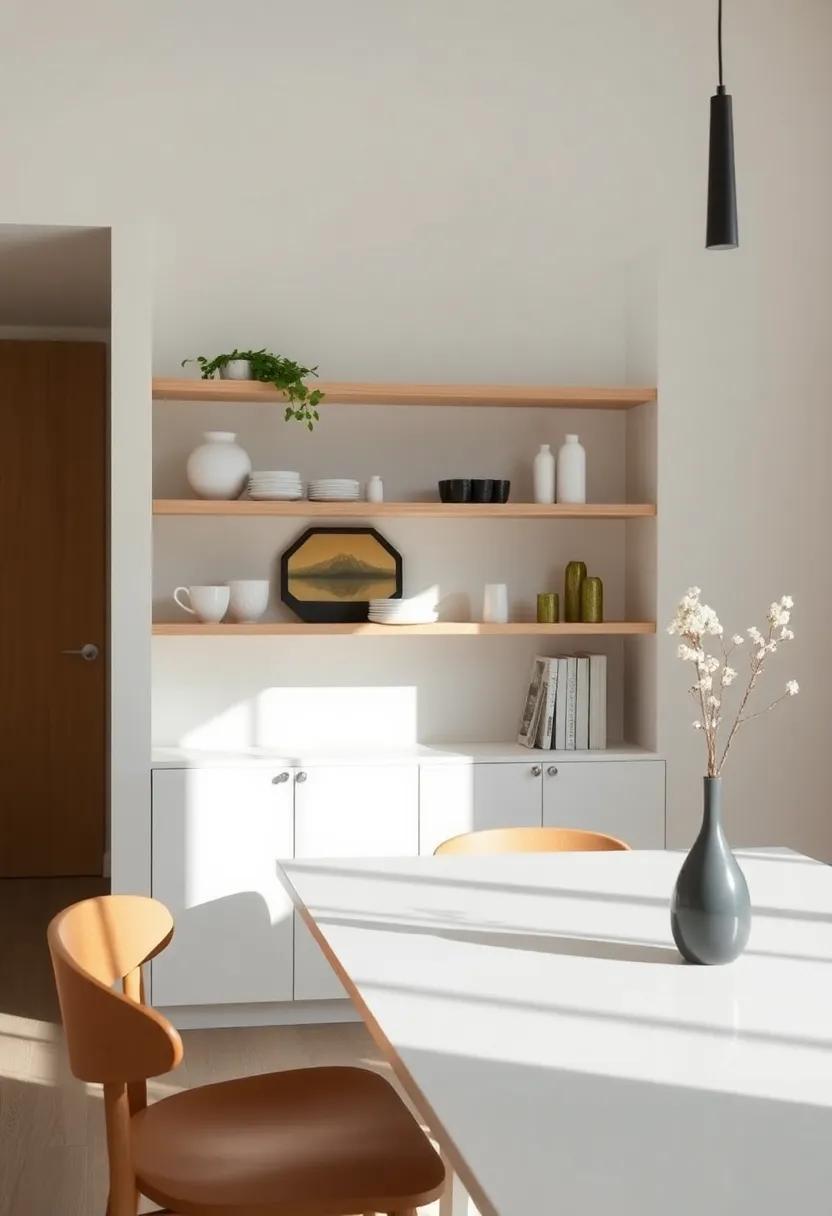
minimalism in decor focuses on the art of decluttering your space while maintaining a sense of style and sophistication. By embracing a simplified aesthetic, you can create dining room shelves that not only serve a purpose but also evoke a sense of tranquility. Consider selecting a few statement pieces that reflect your personality, such as a unique vase or an eye-catching sculpture.This approach allows for open space, enhancing the overall visual appeal and making every item stand out against a clean backdrop.
To achieve a balanced look, think about incorporating design principles like symmetry and repetition.Arrange your selected decor items in groups of three or five to create visual interest,varying the heights for a dynamic effect. Combine functional items—like dinnerware or cookbooks—with decorative pieces to maintain a practical yet stylish display.Below is a simple guideline for creating harmonious arrangements:
| Arrangement Type | Suggested Items |
|---|---|
| Symmetrical | Two matching lamps, one large painting |
| Asymmetrical | mix of vases, books, and framed photos |
| Layered | Stacked books, small plants, art pieces |
Narrative Displays: Telling a Story Through Your Dining Room Decor
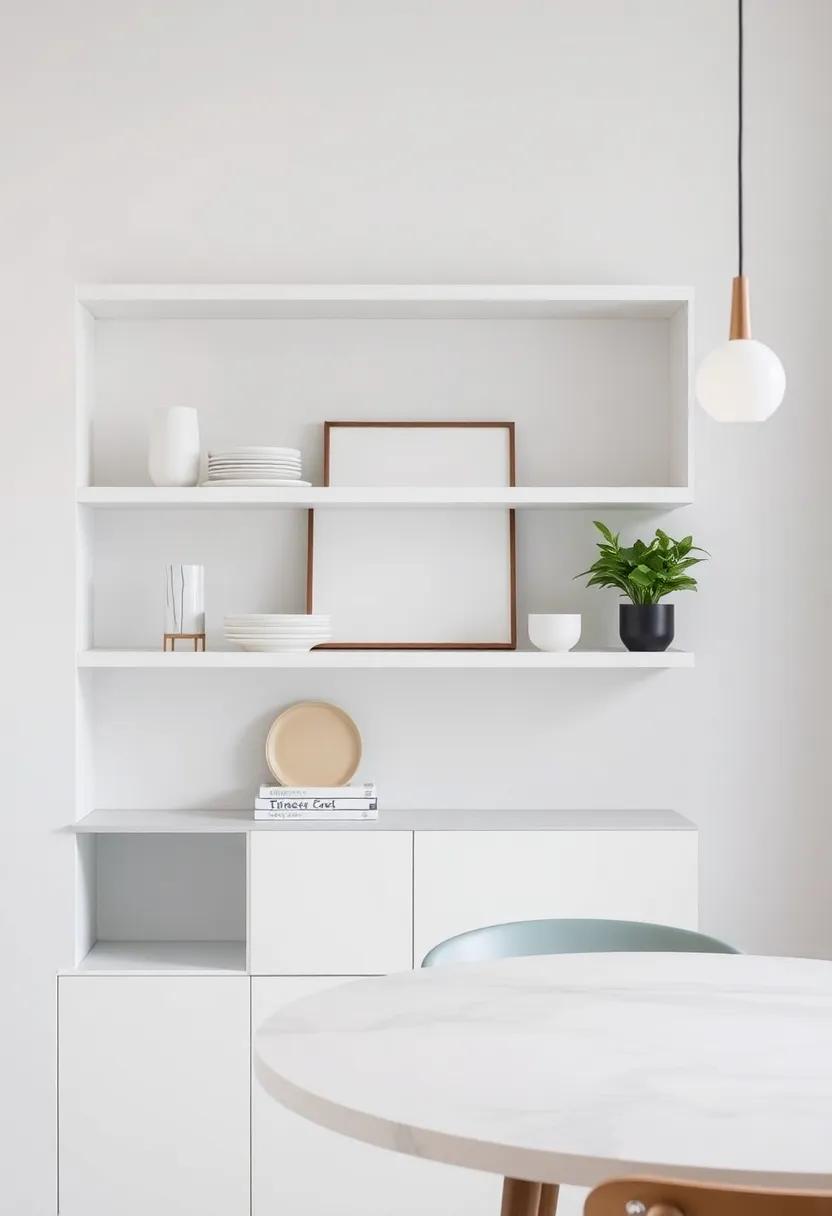
Transforming your dining room shelves into a narrative display not only enhances your space but also invites conversation and connection. By curating a selection of items that resonate with your personal journey, you can infuse your decor with meaning and emotion. Consider incorporating a mix of family heirlooms, travel souvenirs, and artistic elements that represent milestones in your life. Arrange these pieces harmoniously to tell a story, allowing guests to glean insights into your personality and experiences as they admire your carefully crafted display.
To further enrich your narrative, vary the heights and textures of the items on your shelves. Incorporate elements like woven baskets alongside sleek ceramic vases to create visual interest. Here are some suggestions for items that can play a significant role in your narrative display:
- Vintage Cookbooks: Share your passion for cooking and family traditions.
- Framed Photographs: Showcase treasured memories and loved ones.
- Unique Glassware: Highlight travels and special occasions.
- Indoor Plants: Add a touch of life and color to the decor.
| Item Type | Purpose |
|---|---|
| Books | Share knowledge and passions. |
| Decorative Bowls | Showcase natural elements, such as fruits or stones. |
| Art Pieces | Express creativity and style. |
| Candles | Add ambiance and warmth. |
Balancing Acts: How to Harmonize Scale and Proportion on Shelves
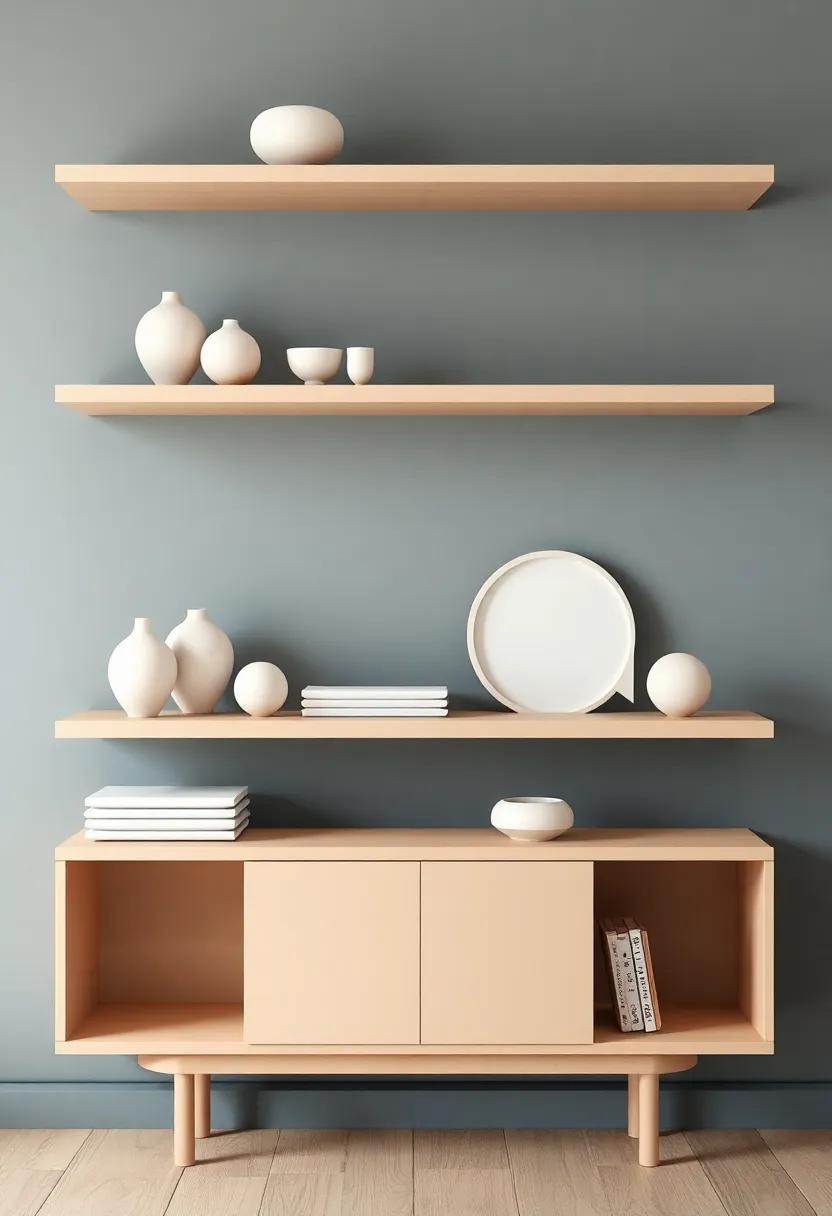
Creating visually appealing shelves requires a careful consideration of scale and proportion. A harmonious display balances larger items with smaller ones, ensuring that each piece complements rather than competes with its neighbors. To achieve this, consider grouping items by size while maintaining a diverse range of shapes.As a notable example, place a tall vase next to a cluster of smaller ceramic bowls to draw the eye upwards while offering a sense of depth. Utilize varying textures—such as smooth glass and rustic wood—to add interest to each grouping, allowing the viewer’s eye to travel across the shelf.
In your quest for balance, think deeply about the negative space left between items.Avoid overcrowding by incorporating strategically placed gaps, which guide the eye and provide a breathing room that keeps the display from feeling cluttered. You might also experiment with layering items by placing books flat and leaning art or decor against them, creating a staggered effect that enhances visual appeal without detracting from functionality. Remember, the goal is to curate a shelf that feels cohesive yet dynamic, where each element is thoughtfully intertwined to tell a story of style.
Incorporating Culinary Elements: Showcasing Cookbooks and Spices
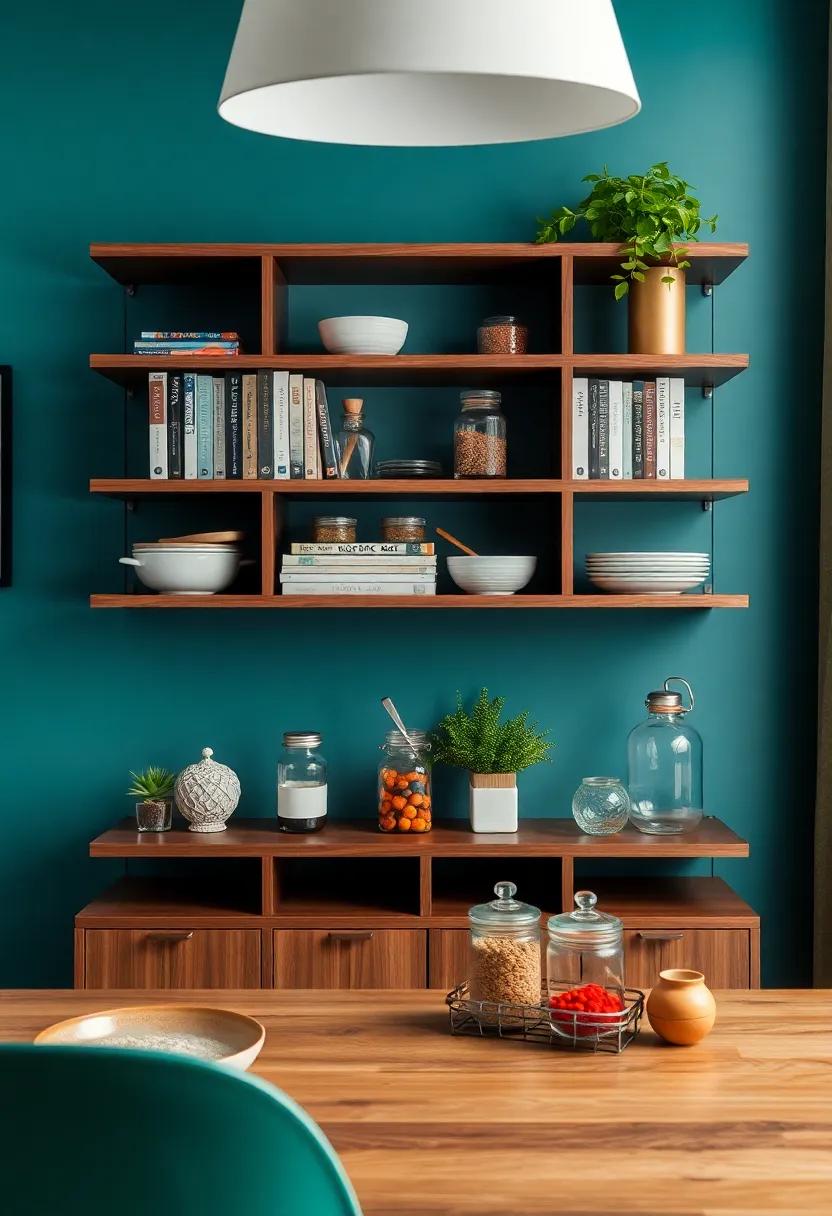
Transform your dining space into a culinary haven by integrating your favorite cookbooks and a selection of vibrant spices. Not only do these elements serve as functional decor, they also inspire creativity in the kitchen. Arrange your cookbooks in an eye-catching way: stack them in groups by color, size, or even genre, letting the covers reflect your personal taste and culinary adventures. Adding a few stands can accentuate their beauty and make each volume accessible, inviting guests to flip through the pages on a whim.
Spices can add both color and aromatic allure to your shelves. Consider displaying an assortment of jars or containers that showcase not only the spices themselves but also their unique textures. Use small labels to highlight each spice, which also contributes character to your arrangement. Here are some fabulous ways to present these culinary essentials:
| Container Type | Ideal For |
|---|---|
| Glass jars | Herbs and spices |
| Wooden boxes | Gourmet salts |
| Metal tins | Seasoning blends |
Layering height with the storage options can create dynamic visual interest. Utilize the vertical space by placing taller jars on the bottom shelf and smaller containers closer to eye level. Finish off with a few decorative pieces, like dried herbs in rustic vases or seasonal fruit, to encapsulate a warm, inviting atmosphere. By thoughtfully curating these culinary elements, you not only elevate your dining room’s aesthetic but also turn it into a vibrant reflection of your culinary journey.
Dynamic Displays: Rotating Decor Items for a Fresh Look Throughout the Year
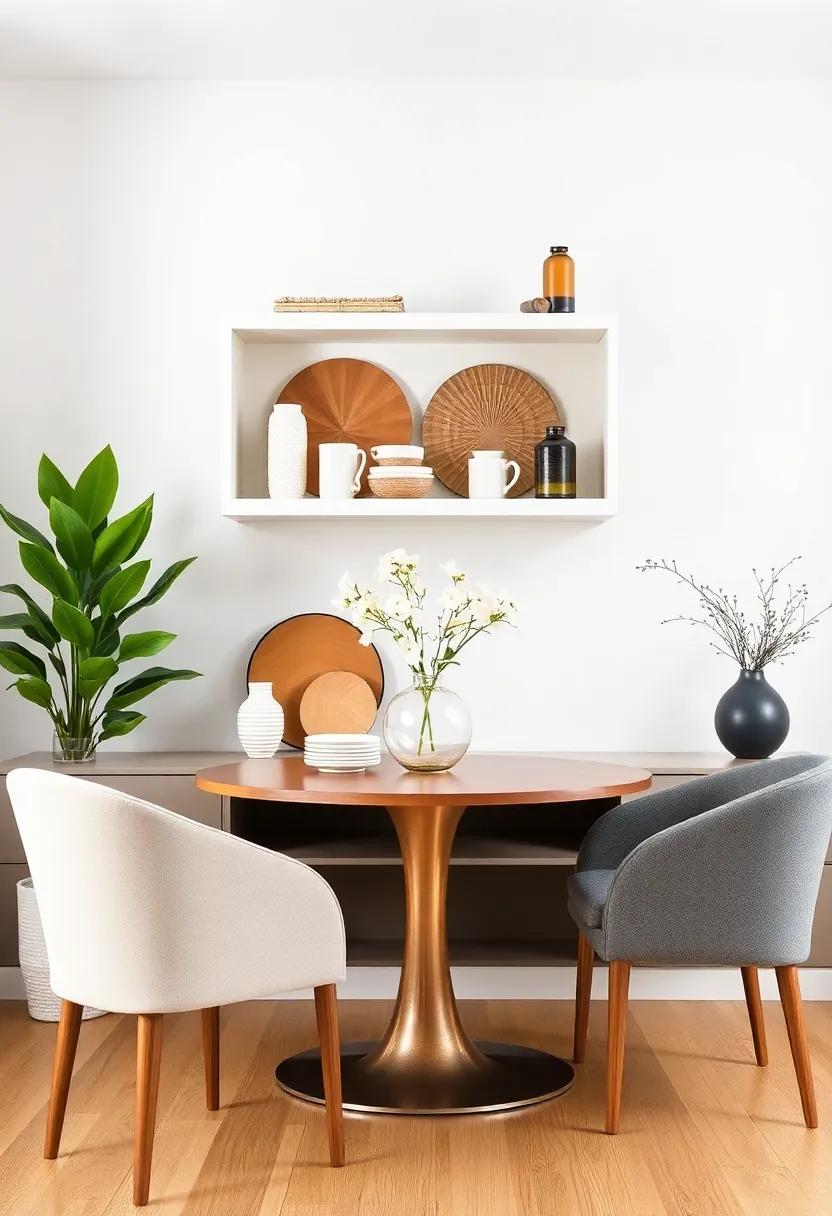
Transforming your dining room shelves into a dynamic visual narrative can be both fun and rewarding. By rotating decor items seasonally or for special occasions, you invite a sense of freshness that keeps your space engaging. Consider incorporating a variety of textures and colors to craft a story throughout the year. For instance, rich yellows and oranges during autumn can be complemented by elegant glassware during holiday festivities, while crisp blues and greens in spring can reflect the blooming nature outside.
Use a strategy of layering, grouping, and varying heights to add depth to your display. recommended items to rotate include:
- Seasonal Decor: Think pumpkins for fall or seashells for summer.
- Artistic Pieces: Rotate in vases, sculptures, or artisan crafts that inspire conversation.
- Functional Items: Incorporate decorative bowls or pitchers that serve a purpose while enhancing aesthetics.
| Season | Decor Items | Focus Color |
|---|---|---|
| Spring | Floral arrangements,pastel ceramics | Soft Green |
| summer | Beach-themed items,vibrant fruits | Bright Yellow |
| Autumn | Harvest decor,warm candles | Rich Orange |
| Winter | Holiday ornaments,cozy textiles | Cool Blue |
Sculptural Elements: Adding Artistic Pieces That Intrigue the Eye
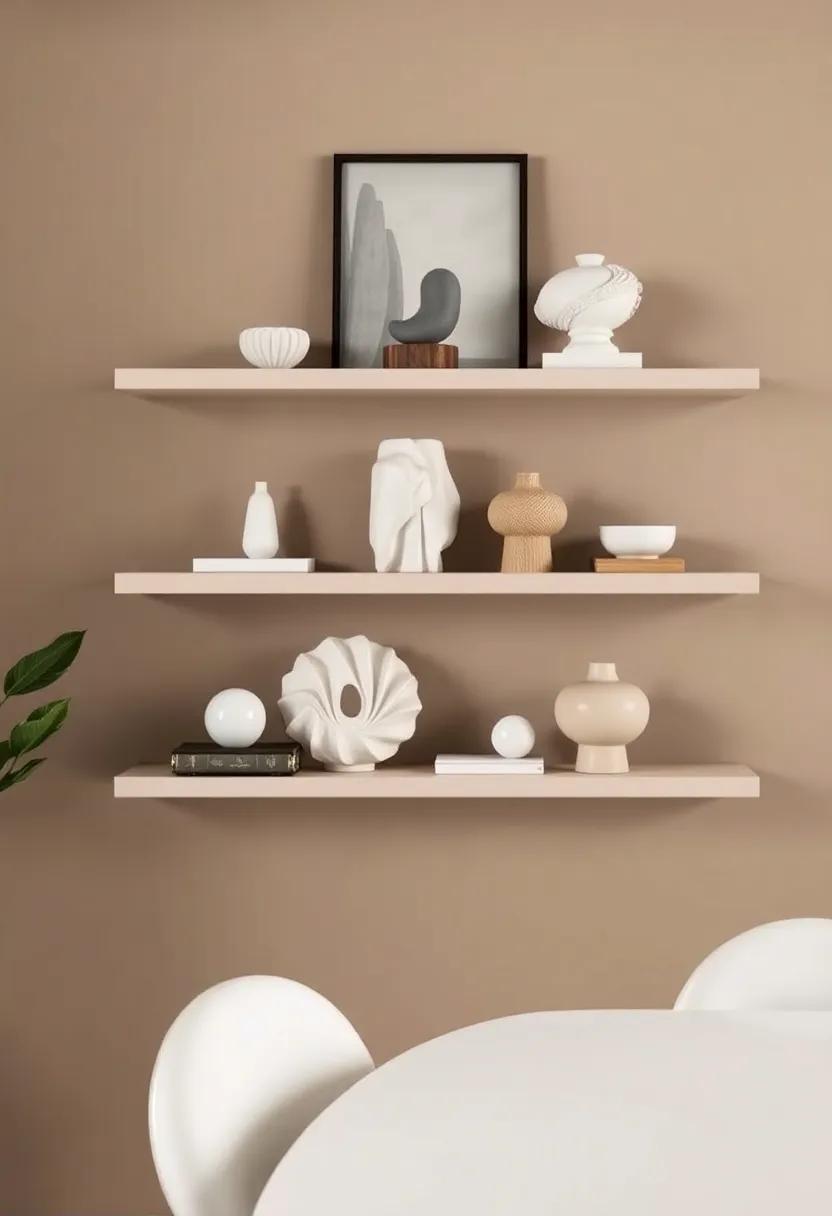
Incorporating sculptural elements can transform your dining room shelves from simply functional to truly fascinating. These artistic pieces serve not only as conversation starters but also as focal points that draw the eye,creating an engaging visual narrative. Consider integrating materials of varying textures and forms to create a dynamic display. You might include items such as:
- Abstract sculptures in metal or stone for an industrial touch.
- Handcrafted ceramics that add warmth and personality.
- Wooden carvings that bring a natural essence to the space.
- Glass art to introduce elegance and light.
When choosing these pieces, think about scale and harmony. Larger sculptures can stand alone on the shelves, while smaller accents can be clustered for a curated look. mixing heights—tall statues, medium vases, and low, flat sculptures—creates visual interest. Here’s a quick reference table to help you select the perfect size and style:
| Size | Ideal Style | Suggested Material |
|---|---|---|
| Small | Minimalist | Ceramic |
| Medium | eclectic | wood |
| large | Statement | metal |
Closing Remarks
styling your dining room shelves is not just about aesthetics; it’s an opportunity to express your personality and create a warm, inviting atmosphere. By thoughtfully curating your collection of books, decorative items, and personal treasures, you can transform these functional spaces into captivating displays that tell your unique story. Remember, the key is balance—intermixing textures, colors, and sizes to achieve a look that feels both cohesive and dynamic. As you embark on this creative journey, don’t hesitate to experiment and adapt these ideas to reflect your style. After all, a beautifully styled shelf can elevate not just your space, but also the moments shared around your dining table. Now it’s your turn to unleash your creativity and make your dining room a true reflection of you!
As an Amazon Associate I earn from qualifying purchases.
